Star Trek Uniforms Fully Explained
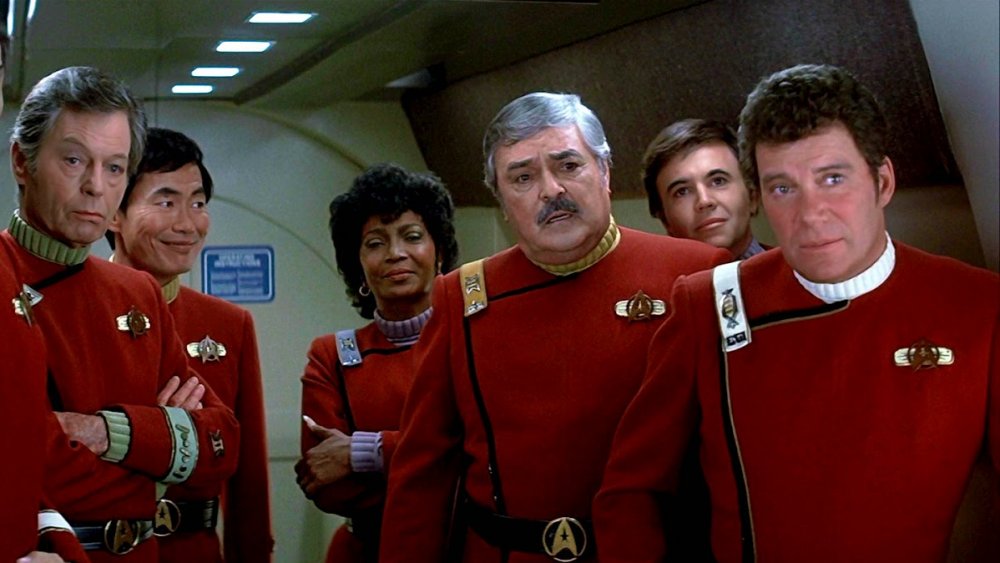
Since its premiere more than 50 years ago, Star Trek has been at the center of a growing web of culture, television, film, and fandom. With nine television series and 13 films, with undoubtedly more to come, there is a wealth of material to analyze and enjoy. Today, an enthusiastic fan can take just a single aspect of the Star Trek universe and dive into it for weeks.
Take uniforms. A seemingly simple concept, right? Star Trek generally focuses on the experiences of people serving in Starfleet, essentially a futuristic version of the Navy in space. So, Starfleet uniforms should be fairly consistent, even boring. Everyone's supposed to look like a cohesive group, so there should be little variation.
However, the uniforms of Star Trek are so varied and connected to the intricate fictional world of the franchise that it's pretty fascinating. Someone appearing on Star Trek: The Next Generation and then showing up again in a film like Star Trek: First Contact will probably have to fit themselves into two very distinct outfits. With more than five decades of stuff to go through, says CNET , there's a dizzying variety of looks for what's supposed to be a pretty staid quasi-military organization.
Practically everything about the history of Star Trek uniforms is linked to behind-the-scenes stories, real-world creativity, in-universe drama, and even a touch of fashion history here and there. From color, to cut, to material, there's a lot to learn.

Color is key to Star Trek uniforms
In Star Trek: The Original Series , which ran from 1966 to 1969, you can't miss the brightly hued uniform shirts sported by the crew of the starship Enterprise . Captain James T. Kirk and other members of the command staff sport golden yellow tops, says Mental Floss . Blue is reserved for the science department and medical personnel, so you'll see it on Mr. Spock, the second-in-command, and the ship's physician, Doctor McCoy.
And what of the folk in red uniforms? According to Star Trek lore, these poor "redshirts" are little more than cannon fodder, though, officially, red is for communications, admin, and security. If you're watching an episode where a random, red-clad crewmember is asked to beam down to the planet with the main cast, don't get too attached. They're probably going to get zapped, eaten, or otherwise annihilated to further the episode's plot.
Of course, there are some exceptions. Statistically speaking, says Nerdist , redshirts are not that bad off. Consider also that red shirts adorn major characters like Scotty, the ship's chief engineer, who made it through the entire series.
Now that you've got that settled, remember that it's only good for one series. In later Star Trek shows, red and gold switched places. Captains like The Next Generation 's Jean-Luc Picard wore a dark red, while his security chief, Worf, wore gold.
Starfleet rank is shown by pips and stripes
Like so many real-world military organizations, Starfleet hinges on rank. Crewmembers are expected to follow orders, but on starships that can carry thousands of people, who are they supposed to take seriously? That's where the rickrack comes in.
In Star Trek: The Original Series , rank was denoted by stripes of gold ribbon on someone's sleeves. The more stripes, the higher the rank. Generally speaking, says Atlas Obscura , two or three stripes means a captain. Commissioned officers are a safe bet for one stripe. Non-commissioned people get either a bit of braid or nothing at all. The stripes were brought back for the reboot films beginning in 2009.
The follow up series, Star Trek: The Next Generation went for something different during its 1987 – 1994 run. The colors became a more muted, and the old rank stripes, which, frankly, looked like something you might have picked up from your local craft store, were retired. In their place, officers wore "pips," subtle little pins, on their collars. The higher someone's rank, the more pips they sported.
Other films played around a bit with the rank symbols, like the different colors and badges shown in 1982's Star Trek II: The Wrath of Khan . Still, they weren't too off the original mark. Generally speaking, the more junk on someone's uniform, the more likely it is that you'll have to follow their orders.
The original series went for velour
Futurama 's Zapp Brannigan character, a send-up of Captain Kirk, is all about his velour uniform. The first Star Trek series really was into luxurious velour, too, but the fabric proved challenging to maintain. It's not as if the 1960s were known for comfortable natural materials, after all.
According to Esquire , the fabric initially used in Star Trek: The Original Series was a little flashy. Costume designers used a stretch cotton velour for the tops, with a black synthetic Dacron infused with sparkles for the pants. Both materials were meant to subtly glitter under studio lights, lending the uniforms a shimmery, 23rd-century, spacefaring feel.
Unfortunately, the velour was a flop. Many called it "that rotten velour," noting that the fabric tended to shrink in the wash and could tear easily. In the third and final season, designers substituted it for a double-knit nylon, says CNET , which proved to be a much hardier fabric, especially when it got thrown into the washing machine.
Captain Kirk's special green shirt was a little embarrassing
Originally, reports Atlas Obscura , the command staff of Star Trek: The Original Series was supposed to be sporting a muted green. Under the studio lights, though, the cameras read the green velour as a golden yellow. The production team simply went with it for the rest of the series.
Careful observers of the 1960s run will note that Captain Kirk is sometimes seen in a very green tunic-style shirt. According to an interview with series costume designer Bill Theiss , that's because it was made out of a different material. That particular shirt looked genuinely green. This is also why some of the colors in the original series seem to change, said Theiss. Even the miniature of the Enterprise could appear ever so slightly green under the right conditions.
William Shatner, the Canadian actor who played Kirk, wasn't necessarily fond of the tightly wrapped look, says Cinemablend . "It was a little embarrassing after lunch to have that tight green thing on you," he said.
Star Trek's women went from pants to miniskirts
The first pilot episode of Star Trek: The Original Series , " The Cage " is an odd duck. Though it was shot in 1964, it didn't make it to screens in its complete form until a Betamax release in 1989. Bits of the story were included in the season one two-parter "The Menagerie," but it contained only the briefest glimpses of what might have been.
These included things like a smiling Spock, different uniforms, and a woman in command wearing pants . Star Trek: The Original Series is notorious for its gendered uniforms. The men wore pants and long-sleeved shirts. Female crewmembers were confined to miniskirts so short that Lieutenant Uhura, the communications officer, always seemed on the verge of an embarrassing situation when she sat down.
That's partially why Number One, the second-in-command in "The Cage," stands out: She's wearing pants. Number One, played by Majel Barrett, is also a daring commander. But she wasn't considered right for the character. When Star Trek got its second pilot, none of the women were in command, and certainly none of them wore pants. Barrett returned, albeit as the emotional, mini-skirted Nurse Chapel.
Nichelle Nichols, who played Uhura, offers up a counterpoint. "I was wearing [miniskirts] on the street," she told the BBC . "What's wrong with wearing them on the air? [...] It was the era of the miniskirt. Everybody wore miniskirts."
The first Star Trek movie shook took uniforms in a weird direction
Star Trek: The Motion Picture looked like it was going to be a big deal. The 1979 film was the first time that fans would get to see their beloved crew on the big screen. Anticipation was high. Then, the movie debuted.
It landed with a dull thud. While die-hard fans still got enjoyment out of Star Trek 's film debut, most viewers couldn't get past the plodding story and dialogue-heavy scenes. It made just enough profit to justify a sequel, to be sure. SyFy contends that The Motion Picture did originate some interesting new trends for the franchise, like wearable communicators and redesigned Klingons . Still, few would point to this entry as their favorite Star Trek movie.
Some of the blame surely lies with the redesigned uniforms. Where The Original Series had colorful, if somewhat cartoonish togs for the crew, The Motion Picture made it look like everyone was going to the weirdest slumber party ever. According to Memory Alpha , the crew was now outfitted in two-piece tunics and one-piece jumpsuits in mind-numbing shades like pale blue and beige. At least the women on the crew were dressed in the same jumpsuits worn by the men. They might have looked oddly dull for space adventurers, but crewmembers like Lt. Uhura didn't look like they needed to worry about errant breezes. And, if nothing else, the space pajamas look pretty comfortable.
The Wrath of Khan redeemed Star Trek uniforms while cutting costs
Though Star Trek: The Motion Picture began the series tradition of changing Starfleet uniforms at every opportunity, rebooted uniforms didn't get very eye-catching until the second film. In Star Trek: The Wrath of Khan, both the plotting and the uniforms got a much-needed upgrade.
To be fair, the striking red jackets of The Wrath of Khan wouldn't have existed as we know them if it weren't for the beige jumpsuits of The Motion Picture . As revealed by Empire , costume designer Robert Fletcher, burned somewhat by his experiences on the first film, decided to stay on in an attempt to redeem his craft. Fletcher still had to work within budget, says Forgotten Trek . Indeed, the budget was smaller, since the studio had been spooked somewhat by the lackluster performance of the first motion picture. As a result, Fletcher rather cleverly utilized the old movie uniforms. His team dyed the tunics red because that was the shade that took best to the fabric.
Meanwhile, Fletcher added a few more militaristic details to the revamped uniforms, like boxy shoulders, stripes, and shiny rank insignia. Fletch referred to it as "Hornblower in outer space," referring to the popular Horatio Hornblower series, set in the era of the Napoleonic Wars. The maroon color proved so successful that it persisted far beyond the film and back onto television with the follow-up series, Star Trek: The Next Generation.
Star Trek: The Next Generation's uniform was all about spandex
While the uniforms debuted in Star Trek: The Wrath of Khan were structured, boxy outfits inspired by military getups, the theme wasn't going to last, for William Ware Theiss, who designed the costumes for Star Trek: The Original Series , was ready to completely revamp even his own designs. Theiss was called upon to design the costumes for the first year of Star Trek: The Next Generation , the follow-up series that premiered in 1987. According to Forgotten Trek , Theiss wanted to pull back from the structured look of Wrath of Khan and return to a softer appearance.
That meant spandex. Specifically, Theiss employed a heavyweight material, of the type often used for swimsuits. He also changed the color scheme, making red the color for command staff, while gold was switched to engineering and security. Blue remained the key shade for medical and science personnel.
While designers might have liked the spandex, it got poor reviews from the actors. The form-fitting material was unforgiving of a heavy lunch or brief dalliance with a slice of cake. Robert Blackman, who replaced Theiss in later seasons, came to the rescue with a different cut and wool fabric. Unfortunately, only the male actors got the best changes, like two-piece uniforms. Female actors like Marina Sirtis, who played Counselor Troi, were stuck in uncomfortable one-piece jumpsuits for a while longer.
Deanna Troi's exception confused Trek fans
In Star Trek: The Next Generation , ship's counselor Deanna Troi was actually a Starfleet officer, but you wouldn't know it from her clothes. While everyone else on staff was wearing the regulation Starfleet uniform, Troi was often stuck in revealing onesies that recalled the first film's unfortunate jumpsuits.
It may have something to do with Troi's gender. As quoted at Forgotten Trek , Marina Sirtis, who played Troi, took a dim view of how the show treated female characters. "The women on this show are very non-threatening," she said. "You don't see women in power positions." Troi was meant to be a soft, caring therapist. Perhaps her clothing was meant to reflect that gentleness, but with an admittedly sexist twist that lowered her necklines and kept Sirtis trapped in revealing spandex for much longer than her coworkers. Too often, her clothes reflected stories where Troi was made to be helpless or even outright dull for the sake of the plot.
Counselor Troi finally got to wear the real uniform in "Chain of Command, Part 1," a season six two-parter. In it, Captain Jellico, an uptight fill-in for Captain Picard, curtly tells Troi to just wear the uniform already. While the impetus for the wardrobe change might have been embarrassing for her character, Sirtis was delighted. As she told the BBC , "I was thrilled when I got my regulation Starfleet uniform [...] I got all my brains back."
The "skant" tried to reach gender equality but fell flat
We should give Gene Roddenberry some credit. While he was often of his time for things like scantily clad secondary characters on Star Trek: The Original Series , he genuinely tried to push back against cultural assumptions. Sometimes, it worked and became practically legendary, as when he helped to create a diverse bridge crew on the first television series. Other times, he pushed for costume parity that simply didn't land.
Roddenberry was involved with the production of Star Trek: The Next Generation from its 1987 premiere until shortly before his death in 1991. He was part of almost everything in the series, including the costume design. As reported by Star Trek.com , Roddenberry directed designer William Ware Theiss to design what became known as the "skant."
This take on the minidress was made out of the same spandex as the other uniforms. It was also meant to be unisex. Crewmembers of any gender would be able to wear the thigh-baring skant. Yet, it was a hard sell. The skant was ever-so-briefly seen on a male crewmember here and there in the first season, says SyFy, but never after that. Female crew like Counselor Troi wore it a bit longer, but actors and viewers alike thought it just made her look like a space cheerleader. Though you can understand what Roddenberry and company were going for, the skant just couldn't stay. It faded into fan lore and obscurity soon after the first season.
Star Trek: Deep Space Nine made the uniforms fit for actual work
Star Trek didn't stop with Star Trek: The Next Generation . The sequel series was followed up by a progression of films and further television series. These included Star Trek: Deep Space Nine , which premiered in 1993 and briefly ran concurrently with The Next Generation . Though both series are supposed to take place at roughly the same time, the uniforms seen on Deep Space Nine were a serious departure.
Costume designer Robert Blackman returned to the jumpsuit design but mercifully stayed clear of figure-hugging, back-breaking spandex, says Forgotten Trek . Instead, the looser jumpsuits were made out of wool. Blackman had, like earlier designers, discovered that wool took dye better than other fabrics and held up to repeated washings.
The softer uniforms looked like they could exist in a real, workaday reality. Characters like Chief O'Brien can be seen in the bowels of Deep Space Nine, a scrappy space station inherited from its previous Cardassian occupants. His jumpsuit, based in part on a mechanic's outfit and NASA workaday gear, looks right at place in the more gritty, realistic world of Deep Space Nine .
Star Trek: Lower Decks brings back color and might explain a big mystery
Star Trek: Lower Decks is an animated comedy series, the first ever to take a look at the ridiculous side of Star Trek . While it's very definitely a silly take on the franchise, the Lower Decks series actually holds a clue to the ever-changing and seemingly inconsistent uniforms across the series.
In part, the uniforms of Lower Decks are an homage to a never-used 1994 redesign. According to Trek Movie , creator Mike McMahan realized the discarded uniform design for the Star Trek: Generations movie was just right for his series. It calls back to The Next Generation just enough to make connections but remains distinct and colorful in its new two-dimensional context.
This latest series might also help explain the constantly shifting Starfleet uniforms. Careful viewers may have already noticed that different ship and station crews sport wildly different looks, even when they're supposed to be taking place at the same time.
Inverse points out the apparent fact that Starfleet uniforms seem to correspond to very specific ships and jobs. Someone sent to a space station like Deep Space Nine would wear one uniform, while another crewmember on Picard's Enterprise would sport something noticeably different. An outside viewer could still see they were Starfleet personnel but might correctly guess they were stationed in different places. The looks on Lower Decks , which are their own unique creations, add more evidence to support this theory.
What Do The Star Trek Uniform Colors Mean & Why Are They So Important?
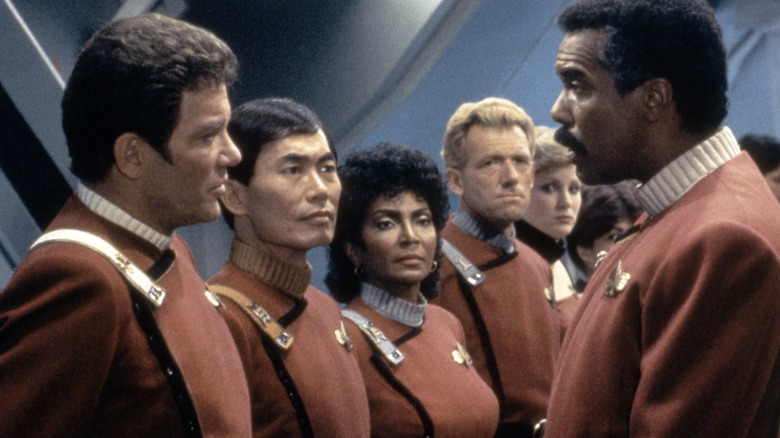
"Star Trek" is definitely a technicolor wonderland of a show. That sense of eye-catching brilliance trickles down from the background scenery to the props used by each cast member, all the way to the uniforms the show's central crew wears as a part of their duties.
It's easy to notice that the crew of the Starship Enterprise wear tunics in varying shades. Those colors are quite important — they denote which job class each crew member belongs to. Those classes were devised by series creator Gene Roddenberry and costume designer William Ware Theiss, and are intended to resemble the classifications used by the United States Military on noise-heavy aircraft carriers.
Sometimes there are differences allowed for dress uniforms; the command staff, for instance, will wear green uniforms during formal occasions. And these rules aren't hard and fast ones; across the whole universe of "Star Trek" series, films, and other ephemera, the colors various officers wear on the show and the meanings behind them change depending on when the scene takes place in the show's general timeline. But these are the color codes that most often denote each character's job on the ship, and the ones used during the original "Star Trek" series to explain who is who and what they do.
The term 'red shirt' gained a negative connotation
Even if you're not a "Star Trek" fan, you've probably heard jokes about how often red-shirted officers are introduced to the show, only for them to quickly die during away missions. For a period of time, the term "red shirt" became a dirty word in the "Star Trek" world; it's gone on to take on a larger cultural significance, indicating that a person is a disposable background element easy to get rid of. And yet many of the show's red-toting characters are the franchise's longest-lasting individuals. The class encompasses the engineering, security, and communication staff positions on the Enterprise. Lt. Nyota Uhura (Nichelle Nichols) and Montgomery "Scotty" Scott (James Doohan) are among the most prominent crew members who wear scarlet hues. To wear red on the bridge is definitely a high honor.
Are 'red shirts' more doomed than their counterparts? Mathematician James Grime weighed in on the subject during a talk at New York's Museum of Mathematics in 2017. A simple statistical calculation revealed that 10% of the show's red-shirted denizens die during the original show's run — compared to 18 percent of golden-shirted characters. "There is some truth in the old 'Star Trek' myth if you look at security officers ... 20 percent of security officers died. So I think the moral of the story is, if you're on the starship Enterprise and you want to survive, be a scientist," he said.
Ironically, crimson red was eventually used to denote a position of authority on the ship; the uniforms that debuted in "Star Trek II: The Wrath of Khan" place the crew in scarlet togs, with no color divisions to mark them.
Blue denotes a scientific mind
If you're feeling blue during your time on the Enterprise, then you're probably logically-minded. Throughout much of the original "Star Trek" series, blue uniforms were given to the show's science and medical officers. That's why Spock (Leonard Nimoy), Nurse Christine Chapel (Majel Barrett), and Dr. Leonard "Bones" McCoy (DeForest Kelley) can be seen sporting blue tunics throughout the series' run. The designation of blue uniforms hasn't changed much during the course of various "Star Trek" series; blue and purple shades are used to indicate ship medics in such continuations of the universe as "Star Trek: The Next Generation."
Blue was also the chosen shade for the crew uniforms in "Star Trek: The Motion Picture," with splashes of brown, oatmeal and white. This change didn't go over well with the cast. Their rebellion against the baggy uniforms went beyond their alleged unsightliness; costume designer Robert Fletcher sewed shoes into the bottom of each uniform, forcing the actors to ask their assistants for help in completing simple tasks such as going to the bathroom. A change was promptly made for the next film, and the red Navy-style uniforms stuck with the whole movie franchise until "Star Trek: The Next Generation" was launched.
Golden shirts denote power
Captain James T. Kirk (William Shatner), meanwhile, sports a gold-colored shirt. These are the outfits worn by those in command: largely, captains and other figures of authority. In other iterations of the show, gold tunics are worn by members of the ship's security staff. In any event, it's a uniform that denotes power.
But those shirts weren't actually intended to be golden at all; in reality, they were pale green tunics that were filmed as golden or orange-looking thanks to the sort of film the show used. According to an interview conducted with Bill Thiess in 1988 for Star Trek Prop Authority , it wasn't the show's intent to present Kirk and other captains as wearing gold at all. "It was one of those film stock things; it photographed one way – burnt orange or a gold. But in reality was another; the command shirts were definitely green." Unfortunately, thanks to that mistake the look has stuck, and Kirk's uniform is more often remembered as golden instead of green.
Whether they're sporting green or dodging danger in red, there's one thing officers on the Enterprise definitely know how to do – look stylish in a timelessly classical way.
What Do the Different Uniform Colors Mean on ‘Star Trek’?
By jason serafino | mar 30, 2023, 3:23 pm edt.
Gene Roddenberry may have dreamed of a perfect future when he created Star Trek , but parts of his vision were firmly rooted in the real world, specifically in the physical makeup of the crew of the Enterprise itself.
Roddenberry, along with the show’s producers, decided to take numerous cues from the United States Navy when creating the official ranks on the show, including a captain overseeing a crew made up of a commander, a handful of lieutenant commanders, lieutenants, and several subordinate roles. But it’s the different colors of the Starfleet uniforms that really tell the story of how the Enterprise operates.
Fans know the basics: an array of blue, red, and gold shirts line the bridge of the ship every episode. Those colors weren’t just randomly picked for the sake of diversity, though. They actually correspond to the ship’s various service roles . The gold shirts are worn by the command division, which includes Captain Kirk, Lieutenant Sulu, and Pavel Chekov. Red uniforms belong to the engineering/communications division, including chief engineer Scotty and communications officer Uhura. The blue shirts are worn by the science/medical staff, including McCoy and Spock .
As with everything in Star Trek , though, it’s a lot more complicated than all of that. In addition to the red shirts belonging to engineers and communications personnel, they are also assigned to the security division. What’s the purpose of the security division on the Enterprise ? Well, they’re usually the supporting characters who are immediately killed whenever the crew is confronted by a new enemy. This is something of a running gag for fans of the franchise, as whenever one of the “Red Shirts” is seen on screen, you know they’re not long for this world .
Also, those gold shirts worn by Kirk and crew might not have been so gold after all. According to an interview with Star Trek ’s costume designer, William Theiss, the idea was for the show’s uniforms to be red, blue, and green. In fact, on the set, Kirk’s outfit certainly looked to be an avocado (or lime) green, but the end result was a little different when the studio lights finally hit the uniform.
“It was one of those film stock things,” Theiss said, “it photographed one way—burnt orange or a gold. But in reality was another; the command shirts were definitely green.”
This might come as a surprise to Trek fans until you remember that Kirk actually did wear green on a few occasions, including the times he was in formal dress and his seldom-seen alternate green get-up, seen in the clip below.
These alternate uniforms were all the exact shade of green Theiss describes, but they were made from a different material than the standard Enterprise shirts and apparently had no issue retaining their natural color scheme when lit on set. The gold shade may have been a production mishap, but the color has since entered the Trek canon as the official hue of Kirk and his command staff. So, in the Star Trek universe, Kirk wears gold; in the real world, though, the bridge of the Enterprise was designed with a completely different color palette in mind.
It gets more confusing when you look at the later Trek series, like The Next Generation , which had the command staff in red and operations in yellow—basically the reverse of the original series. Then, of course, the movies switched costumes and colors with nearly every entry, including the powder blue monstrosities worn in Star Trek: The Motion Picture .
Roddenberry’s eye for detail was unique for sci-fi TV at the time, and everything on the Enterprise had a specific purpose. Despite some production fumbles, ill-fated redesigns, and inconsistencies later on, the colors that make up Starfleet’s uniforms tell a story that many viewers probably never even noticed.
A version of this story originally ran in 2016; it has been updated for 2023.
- More to Explore
- Series & Movies
Published Mar 5, 2021
You Wear It Well: The Uniforms of Star Trek
Turns out, "dress for the job you want, not the job you have," might still be a phrase heard in the 23rd Century and beyond!
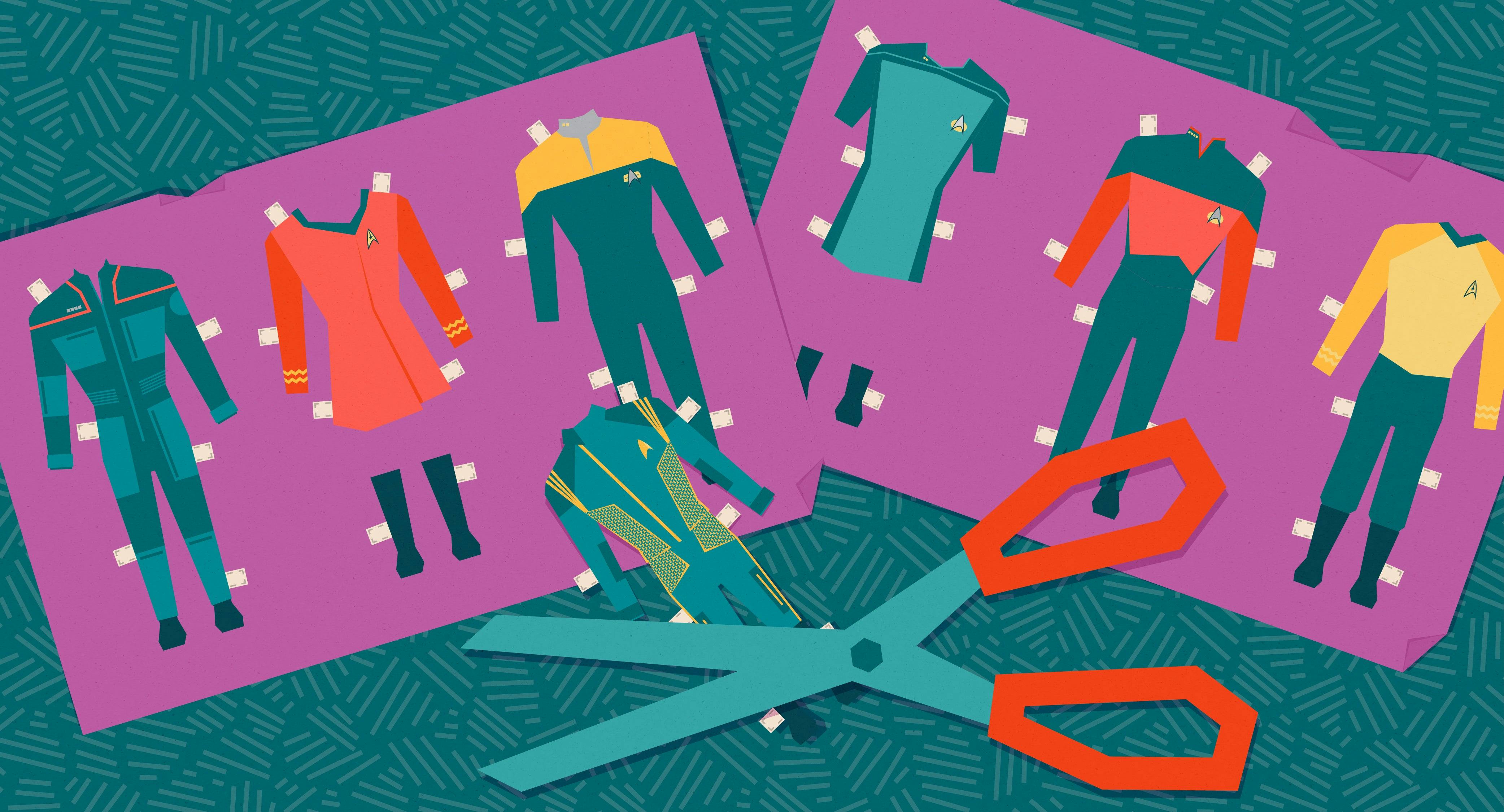
StarTrek.com
The Delta Shield. The colors: red, gold and blue. The form-fitting jackets and often black trousers. Even the confining jumpsuits. Star Trek uniforms have a special place in pop culture, equal in renown maybe only by the jerseys and full kits of certain sports teams. Let’s take a look at some of the uniforms over the years and what messages they are sending to the galaxy.
Star Trek: Discovery — Of Terran Capes And Crowns with Gersha Phillips
Star Trek: The Original Series

The TOS uniforms are arguable the most recognized and iconic of uniforms in the canon. They are the blueprint for all other uniforms in Star Trek . While they carry some of the elements from the “The Cage” unaired pilot episode — tunic-like top, Section colors, black capri-length trousers and boots — the cut and fit of the garments are narrower, the colors much sharper and for the women, no pants. Looking back from our vantage point the uniforms feel more inspired by the 1960s' mod culture, or the era’s British rock bands, not what a fleet of earth-based space explorers would be wearing in the 23rd Century. However, the athleisure vibe of it all was as portentous to our time as the TOS-inspired technology and gadgets that we use on a daily basis. Comparing these uniforms from the garments of other space traveling cultures seen throughout TOS is where you can really see the youthfulness of Starfleet. While Romulans’ uniforms echo the turtleneck silhouette, knit fabric and ultra miniskirts of Starfleet, the rigid textures, exaggerated shoulders, and the addition of a scarf or half vest overlays connotes a sense of the authoritarian militaristic society. Comparing the two looks, without context, you wouldn’t be at fault for easily assuming that Starfleet was the newest team in a galactic travel league.
Star Trek: The Next Generation

Star Trek: The Next Generation was all about the jumpsuit, with a touch of individuality. The best examples of this is Lieutenant Worf’s beautiful Klingon military sash or baldric and Lt. Troi’s flowing dresses and jumpsuits. The Next Generation also famously changed command colors from gold to red, ending a fan favorite “red shirt” trope from TOS. You see other examples of Starfleet uniform styles on the flagship Enterprise , including skants and tunics. The men’s TNG dress uniforms could even be worn as dresses due to their somewhat elongated line. However, from a design and storytelling point of view, the jumpsuit's utility is matched with the artful graphic design which evolves easily into the dress uniform’s elegance and formality.
Into the #Starchive Featuring Captain Picard's Uniform
We can see Starfleet’s evolution of mission and the number of lightyears traveled in the precision of the TNG uniform. Interestingly, the need to continuously mirror the delta design — in the shoulders, sleeves, even in the transition from bodice to trousers both section colors, front and back — is like a monogram. For the many species Jean-Luc Picard and his crew will make First Contact with, this uniform conveys a simple message: We are Starfleet.
Star Trek: Enterprise
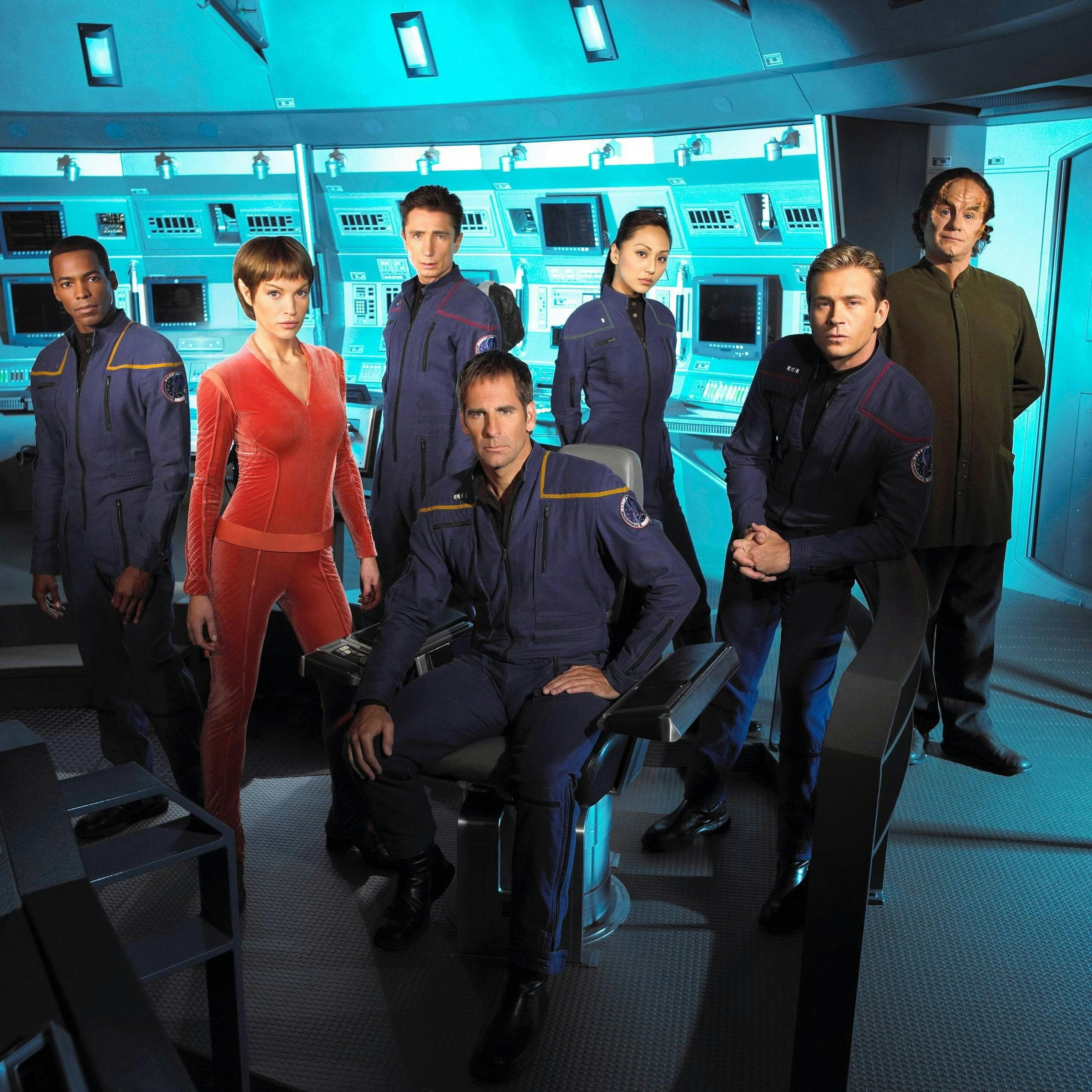
We cannot talk about jumpsuits without talking about Star Trek: Enterprise ! The uniforms on this series most closely represent what our beginnings of further flung space travel might look like. In fact, rather than trying to create something that feels brand new and “science fiction,” the Enterprise crew looks like a team from the National Aeronautics and Space Administration (NASA). The command colors are placed in a simple elegant line framing the shoulders ending, of course, in a point or delta shape. The jumpsuits have the wonderful addition of actual pockets, which actually makes you wonder where all the pockets have been all of this time. Hallelujah — there will be pockets in the future! The jumpsuits are reminiscent of a behind-the-scenes pit or union crew, workers who are laying the important foundation for the future. Yet, similar to workwear from the 20th Century, there is an elegance of how a non-gender specific garment function matches and enhances its form. A more advanced culture may be more fancily dressed, but no one can jump on a nacelle rigging faster than Charles “Trip” Tucker, III.
Star Trek: Deep Space Nine and Star Trek: Voyager
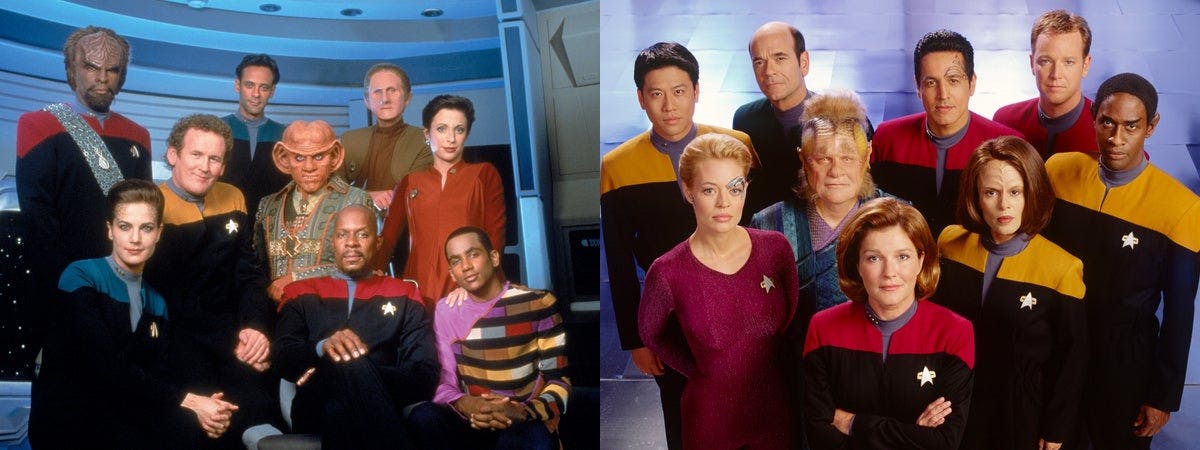
These series combine the streamlined look of the TNG jumpsuit with the function of Enterprise series jumpsuits — jackets, pockets, and pleated trousers. The colors: command red, operations gold, and sciences blue continue with the addition of a mock turtleneck undershirt in grey, which evolves later in a uniform variant where the section colors are the turtleneck and the upper bodice detailing is a quilted grey. Grey as a standard color for Starfleet uniforms appears in Star Trek: The Motion Picture and seen again in Star Trek: Discovery season 3, discussed below.
Into the #Starchive with Captain Janeway's OG Uniform
Deep Space Nine uniforms are particularly interesting in the way all clothes are, in relation to the places and people we associate these outfits with. What makes DS9 unique is the variety of dress everywhere on the starbase, from the Bajoran military uniforms with even more emphasis on the upper bodice and shoulders than Starfleet’s uniforms, to the regalia of the Bajoran monks.In the context of running a space station, Starfleet uniforms need to balance a message of both authority and hospitality. In a sea of colorful people and outfits on the space station’s promenade, the Starfeet uniforms’ relative dark color scheme is the easiest to recognize.
Star Trek: Discovery (Seasons 1-2)
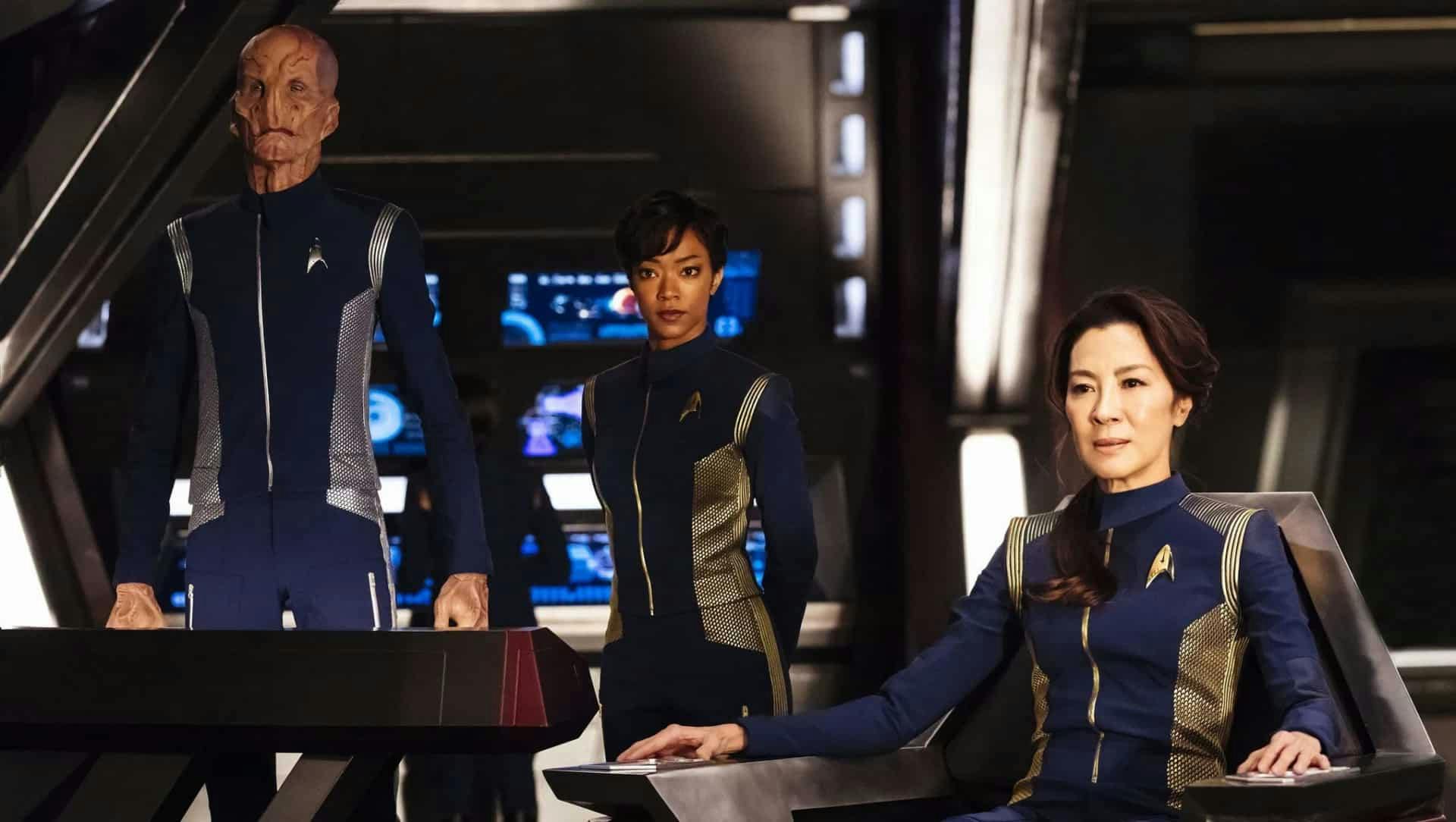
At first glance the Discovery uniforms ignore all previous series. However, there are nods to past series that reveal themselves. While no longer jumpsuits, the jacket, and trouser-leggings of Discovery are blue and thus similar to the Enterprise series. As the series is set between Enterprise and TOS this for me, as a fan, a welcome nod. Most startling is the loss of the iconic red, gold and blue color scheme, it is seen nowhere unless you count the reddish-bronze for Operations. Out of all the series the Discovery uniforms are the most formal. Comparing them to other series, they in fact look like the uniforms of people who have been traveling throughout the galaxy for some time. The form-fitting suit with metal rather than rainbow colors seem to say, “We mean business.” Discovery leans into a militaristic style, more than with previous series. From the rigidity of the jacket to the stripes at the shoulder the uniform appears to, if not welcome , then at least expect conflict and war. The subtle pips on the delta shield could be interpreted to mean that while rank is important, the crew of the Discovery is a family — a band of brothers and sisters equally important and valuable as a captain or admiral. The biggest hint to where this series is going is the asymmetry introduced into Starfleet uniforms for the first time. The eschew collar which creates a delta shape in the front of the face (invoking TOS’ uniform) is closed by a bold metallic zipper that goes from the left of the neck to the center at the jacket bottom. These off-center details could be interpreted to mean that unexpected outcomes are coming!
Star Trek: Discovery (Season 3)
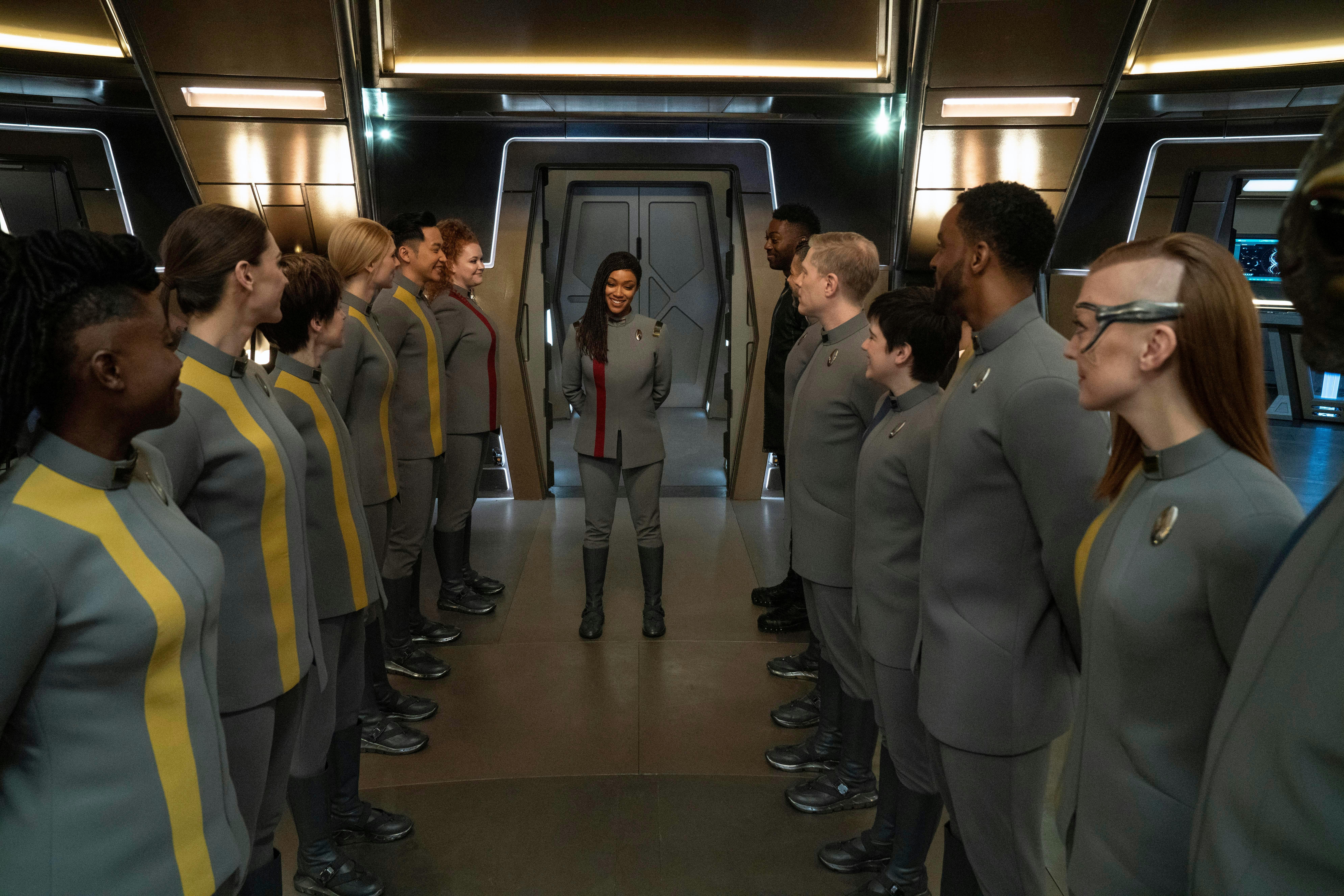
A conversation about Star Trek uniforms would be incomplete without some mention of Season 3’s far-flung future Federation uniforms. It’s not hard to see where these new uniforms took inspiration from other Trek series. In addition to the grey color seen most notably in Star Trek: The Motion Picture , the quilted-ridges at the top of the jacket mirrors that of Deep Space Nine ’s uniforms, and the asymmetry at the bottom of the jacket reminds us of Discovery ’s earlier uniforms. Season 3 even brings back the red, gold, and blue for command, operations, and sciences, this time in a bold sculptural color block down the right side of the jacket. Its appearance seems to state that knowing you and your colleagues’ place in the Federation and on your ship of duty is paramount for rebuilding. This is no time for subtlety. While this same meticulous design could also be overcompensation for the reduction of the Federation’s place, power, and purpose in the 32nd Century it could also be the Federation’s way of “dressing for the job you want (the premiere intergalactic union of planets), not the one you have.” And that’s a tip we can all take with us, to the board room or the Ready Room.
Designer Gersha Phillips Looks Back on Discovery Season 2 Costumes
Bio: Tereneh Idia (she/her) is a writer, fashion designer and fashion educator who has taught and designed in Pittsburgh, New York City, Nairobi, Kenya, Singapore and Bali, Indonesia. While missing out on Star Trek as a child, she expects the rest of her adult growing up to be inspired and entertained by Star Trek.
Star Trek: Discovery streams on Paramount+ in the United States, airs on Bell Media’s CTV Sci-Fi Channel and streams on Crave in Canada, and on Netflix in 190 countries.
Get Updates By Email
- Celebrities
- Secret Invasion
- The Marvels
- Disney Plus
- Apple TV Plus
- Dwayne Johnson
- Brie Larson
- Ryan Reynolds
- The Witcher
- About & Advertising
- Affiliate Policy
- Privacy Policy

‘Star Trek’ uniform colors, explained
Everyone knows the iconic Star Trek uniforms. The brightly-colored outfits amazed viewers seeing color TV for the first time in the 1960s and helped to define the unique aesthetic style of the Star Trek universe, becoming an instantly recognizable feature of the shows.
The 23rd Century
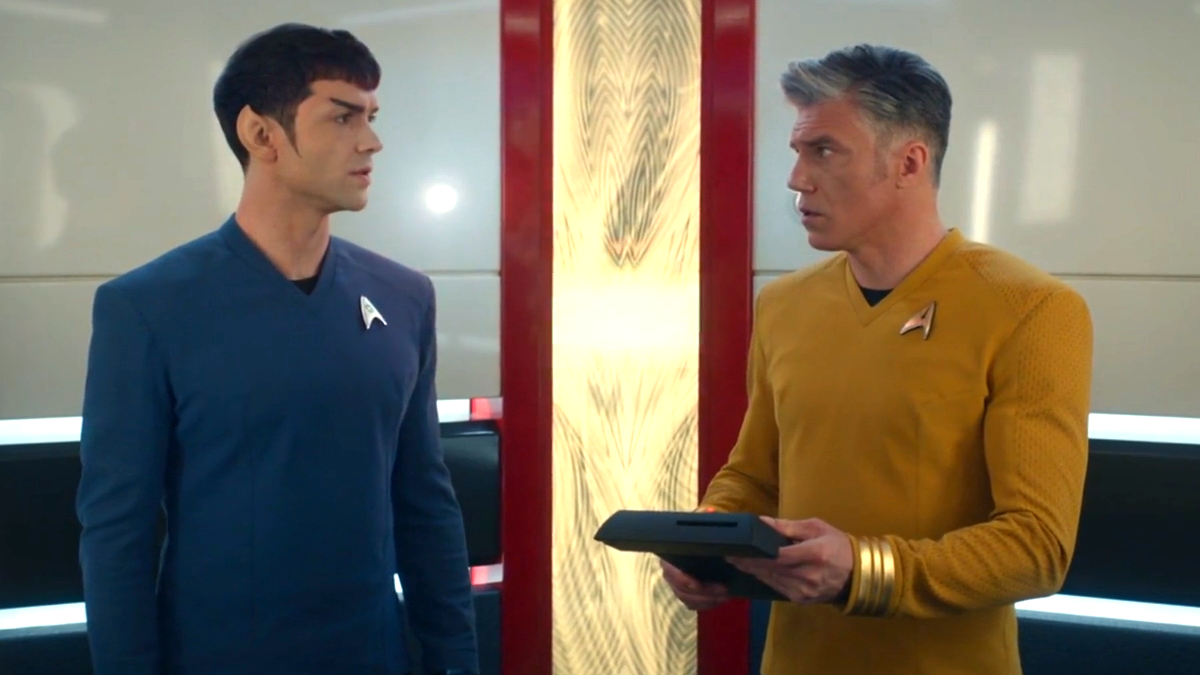
In The Original Series , there were three uniform colors . Each color represented a certain duty division aboard a starship or station. Gold, as worn by Kirk and Sulu, denoted the command division of Starfleet, which included most ranking officers and administrative personnel. Blue, as worn by Spock and McCoy, denoted the sciences division. This included researchers and medical staff. Red, as worn by Uhura and Scotty, denoted the operations division which covered a wide range of specializations such as engineering and security. Each color choice was bold and striking, meaning viewers could immediately tell what position any new character had in Starfleet.
The Original Series gave rise to the infamous phenomenon of “redshirts.” Security officers wore red shirts and would regularly put themselves in harm’s way. Enterprise crew clad in red were massively more likely to be killed than their counterparts in the other divisions. A redshirt’s life could be painful and short — they would be blown up by alien weaponry, plunge head-first into bottomless chasms, or even have all their red blood cells surgically removed by malevolent cloud creatures. Around 26 officers in red uniforms died during the course of the series’ three-year run. In the season two episode “ The Apple ,” four unfortunate redshirts are killed navigating a jungle deathtrap, being struck by lightning, shot by plants, and falling onto landmines. Even by the cruel standards of the show, this ranks as a bloodbath.
Strange New Worlds — set very shortly before The Original Series — keeps the same uniform colors, but adds a new one. A white uniform denotes someone working as a member of medical staff, but these were seemingly phased out in favor of standard blue uniforms by the time of The Original Series .
Star Trek: Discovery , a prequel series set a little further prior to The Original Series , introduced a new color-coding system. All uniforms were made of dark blue fabric, with division denoted by metallic stripes on the shoulders. These stripes were gold (command), silver (sciences), and copper (operations). These clothes were super-sleek but looked too much like Navy uniforms, and it could be hard to tell at a glance who was part of what division.
The 24th Century
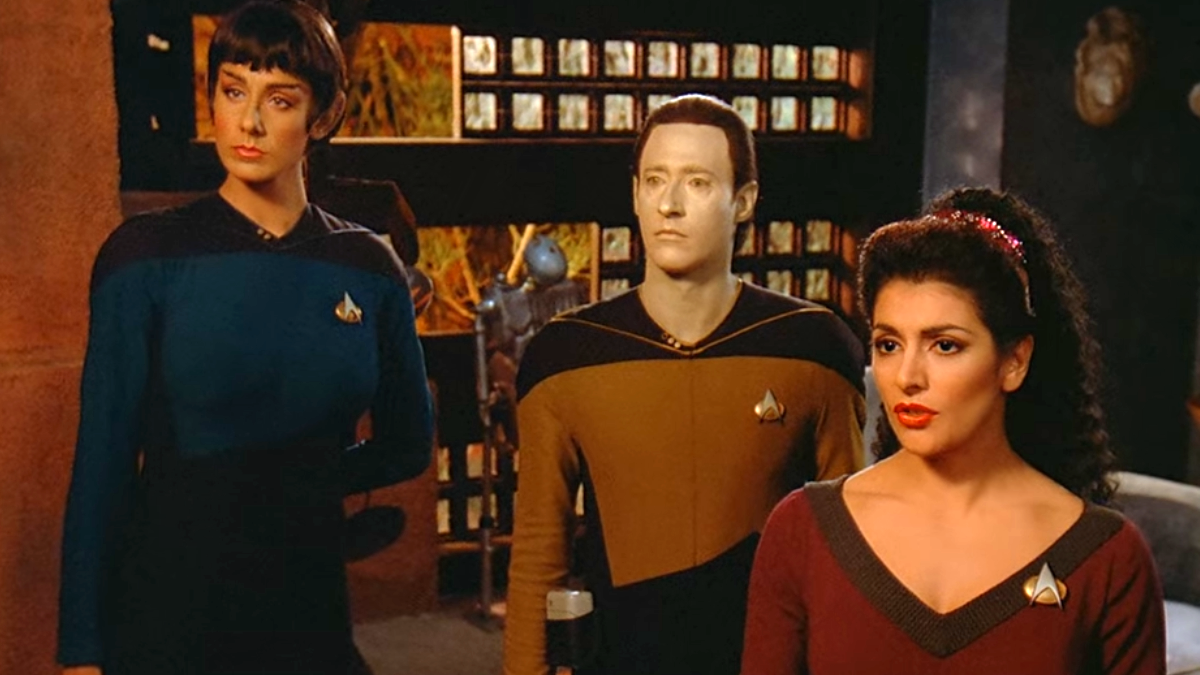
By The Next Generation , the uniform colors had changed . While blue still denoted science and medical, the meanings of red and gold were inverted. No reason was ever given in-universe for this, but the real-world explanation is that Next Generation actors looked better in certain colors — Brent Spiner as Data, for example, was deemed to look far better in gold than in red or blue. The change also came partly as a result of the Star Trek movies of the 1980s, where all Starfleet personnel were shown to wear red uniforms (the fabric for the costumes took better to red dye). Kirk had been seen wearing red for the movies, so it was felt that audiences would come to associate red with command.
Whatever the century, series, or ship, Star Trek just wouldn’t be the same without everyone clad in brightly colored pajamas. Too many modern science fiction shows have their actors wear drab, dark, soulless uniforms. Strange New World s is proudly carrying on the multi-colored tradition set way back in 1966.

- Sep 7, 2023
Star Trek Uniforms: The Meaning Behind The Colors
When the original Star Trek series premiered in 1966, it wasn't just the groundbreaking storytelling that caught the audience’s attention; it was also the iconic uniforms worn by the crew. The most striking feature is the bright color scheme. The uniform colors were used to help viewers instantly recognize the roles of the crew. Command officers like Captain Kirk wear gold; science and medical officers like Spock and McCoy wear blue; engineering personnel like Scotty and security officers wear red. These colors were specifically chosen to be visually striking on the color TVs that first became widely available in the 1960s when the show first aired.
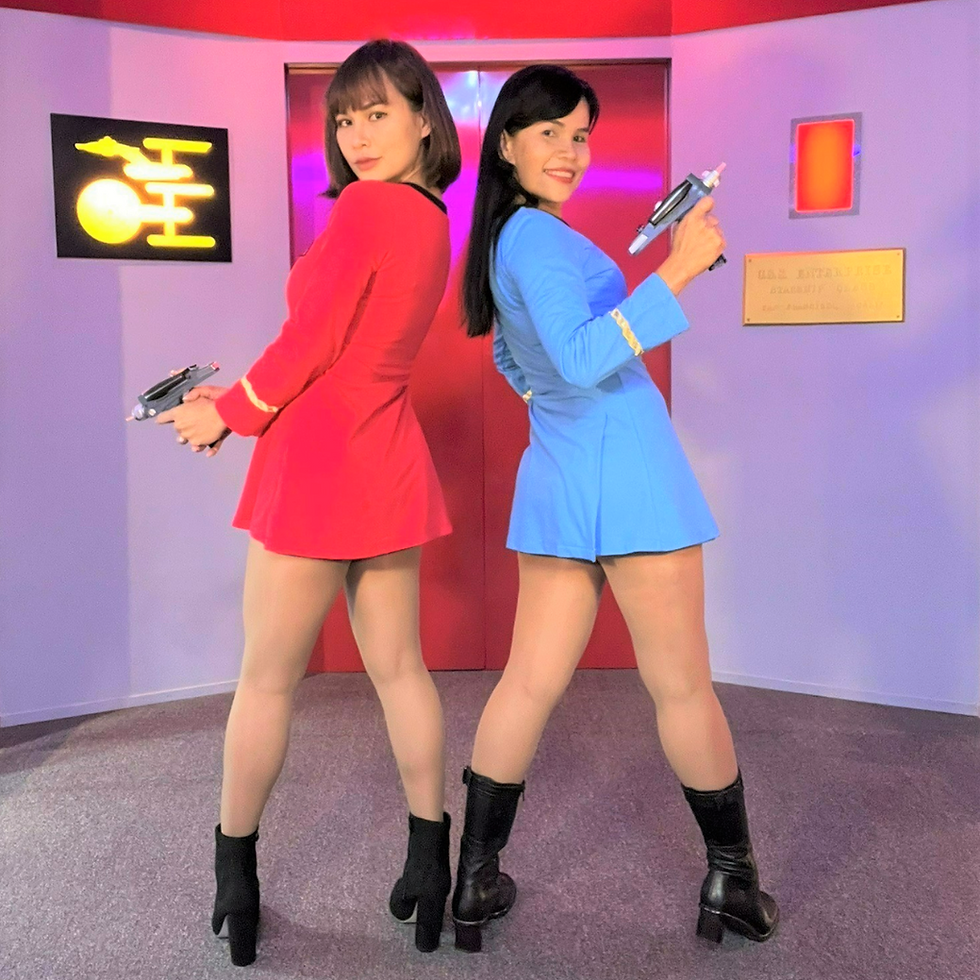
So, what was the actual meaning behind the selection of uniform colors?
Gold, worn by command officers, was chosen to symbolize the importance of strategic decisions.
Blue, worn by science and medical personnel, represents those engaged in the exploration of both outer and inner frontiers: the universe and the human body.
Red, worn by engineering crew members and security staff, stands for the heart of the ship: the people who keep it running.
With regard to the women’s short uniform dresses, these were tastefully designed, and there was an emphasis on the characters' confidence, competence, and individuality.
At that time, this marked a significant departure from the stereotypical portrayal of women in science fiction as mere eye-candy or damsels in distress. Women were portrayed as capable professionals in functional and stylish attire.
And so the choice to use different colors for the uniforms was an intentional decision to visually represent the different crew member’s functions within a team. It symbolized the show's underlying belief in a future where the clear diversity of roles and responsibilities are essential in contributing to the unified mission of successfully exploring the galaxy.
Subscribe for photos and articles
🖖😍 Star Trek Gigi
Recent Posts
The Sexy Influence of Star Trek Short Dresses
I wonder why they changed the colors in the TNG era. Maybe Red just felt like a Command color...
This was an amazing read and I now know the reasons for the colours. I love the TOS uniforms. They are my absolute favourites. If only we saw a man wearing those miniskirt uniforms to show even more diversity. That would have been awesome. Either way, the TOS uniforms looks good and served a purpose whilst not seemingly being militarised. A beautiful blog. 😊🙏🖖❤
You are very welcome, Gigi. 😍❤🖖

Star Trek Uniform Color Meanings
What is the meaning of the uniform colors in Star Trek? This post will cover the original crew, the next generation (TNG), and beyond, including deep space 9 (DS9), and Voyager.

Generally, the different uniform colors helped to differentiate between the different duty positions, levels of authority, and generally the command structure of the federation, and the crew on the starships.
In the Star Trek universe, the colors of the uniforms worn by crew members hold specific meanings. Let’s break it down:
Original Series
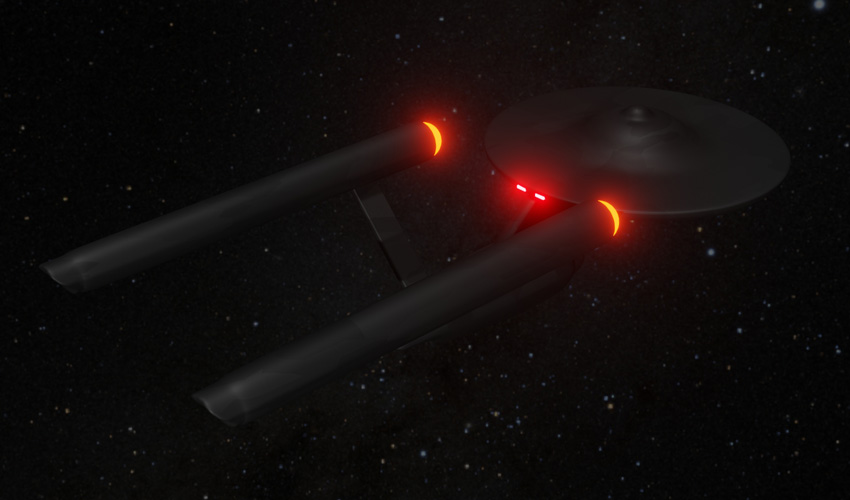
Red Uniforms: These are typically worn by crew members in engineering, security, and communications roles. Notably, Lt. Nyota Uhura and Montgomery (Scotty) Scott wore red uniforms. Wearing red on the bridge is considered a high honor. However, there’s a running joke about crew members in red shirts often meeting unfortunate fates during away missions. So, if you’re on the Starship Enterprise and want to survive, don’t wear red!
Blue Uniforms: These represent medical and science divisions. They’ve remained consistent across various “Star Trek” series. Blue shades indicate ship medics and scientific personnel.
Gold Uniforms: Worn by command officers, gold symbolizes the importance of strategic decisions. Command staff, including Captain Kirk, would wear these iconic golden shirts.
TNG, DS9 & Voyager
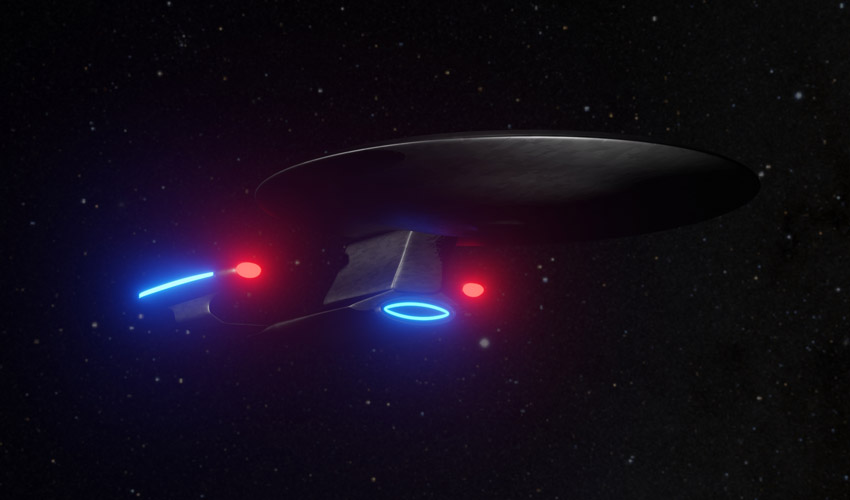
In Star Trek: The Next Generation (TNG), and beyond, not only did the uniforms modernize, the color meanings changed. Let’s delve into the significance of each uniform color:
Red Uniforms: These are worn by command staff. Captain Jean-Luc Picard and his senior officers sport these crimson hues. Red signifies leadership, decision-making, and strategic roles. If you’re in red, you’re at the helm of the starship, making critical choices for the crew and the mission.
Blue Uniforms: Medical staff wear blue. Dr. Beverly Crusher and other medical officers would have a blue uniform. This remains the same as in the original series.
Gold Uniforms: Operations and security staff wear gold. Lt. Commander Geordi La Forge, Lt. Worf, Lt. Tasha Yar, and Chief O’Brien fall into this group. Gold symbolizes efficiency, engineering, and tactical prowess. These officers keep the ship running smoothly, maintain systems, and ensure security.
In summary, the colors of Starfleet uniforms reflect the crew members’ roles and responsibilities as they explore the final frontier!
Why The Uniform Colors Change?
The switch in uniform color in the 24th century likely aimed to move away from the negative connotation associated with “redshirt” deaths, those unfortunate crew members who often met their demise during away missions.
The evolution of Starfleet’s uniform colors reflects different visions of the franchise’s costume designers over the past 50 plus years. Each new designer brings their own perspective, adapting the color meanings while honoring the legacy of this beloved sci-fi saga.
Related Colors & Posts

Similar Posts
Use of different colors in retro games.
How were colors used when it came to old retro games, why different characters had different colors? As a child I loved video games. The arcades were heaven for me as a child. I particularly found the usage of different colors fascinating in certain video games. The different colors signify different things with different meanings….
Lightsaber Color Meanings
In the world of Star Wars, the lightsaber is one of the most memorable and iconic objects within that universe. So what are the lightsaber color meanings for red, green, blue, purple and others, the weapons of the Jedi and Sith mean? Lightsabers actually get their color from what are known as kyber crystals. However,…
The Colors of Tron & Meanings
Looking into the colors and their meanings of the Classic science fiction movies Tron, including the original 1982 classic Tron, and the much more recent sequel Tron Legacy. 1982 Film Tron Tron is a 1982 American science fiction action-adventure film directed by Steven Lisberger. It stars Jeff Bridges as Kevin Flynn, a computer programmer who…
- Movies & TV
- Big on the Internet
- About Us & Contact
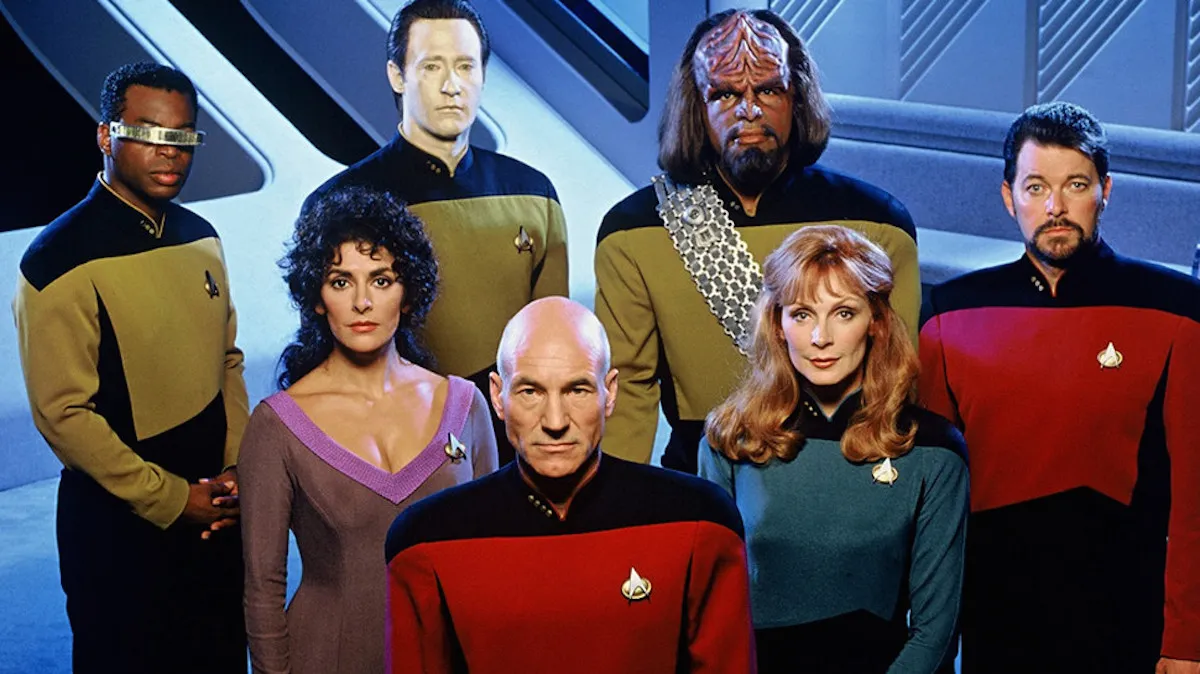
A Guide to the Different Uniform Colors the Characters Wear in ‘Star Trek’
Star Trek: The Original Series premiered in 1966. And in the year 2022, the franchise doesn’t seem to be slowing down soon. Currently, there are several ongoing television series with a new film and series recently announced.
I was a toddler when Star Trek: The Next Generation came out in 1987, making Picard’s Enterprise crew one of my earliest memories. I still love the series (as I sip out of my Chateau Picard wine tumbler). But the meaning of their uniform shirts eluded me for the longest time. Honestly, I thought you just picked your favorite color outfit when you joined a crew. After the “redshirt” trope (where a redshirt team member was more likely to die on a Star Trek away mission) became known, I thought there might be more to it. Apparently, there is a whole color-coded system in place. And the meaning of the colors changed slightly through the various shows.
The Original Series
For the original Star Trek series and the Enterprise prequel that came later, the uniform color breakdowns are:
Red – Engineering, Security, and Communications
Blue – Science and Medical Staff
Gold – Command Staff
Green – Command Staff Formal
The original series is where the redshirt trope comes from. It always seemed like if a random character in a red shirt went on an away mission, then they were not making it back to the ship. The largest group of people wore red uniform shirts, which would make it more likely that a person who died or got injured would have a red shirt on.
The Next Generation
When The Next Generation arrived, the series changed several things from the original, including the uniform colors:
Red – Command Staff
Gold – Operations and Security Staff
TNG , more so than the original series, set the template for most future shows. Even though the uniform styles changed, the color classifications stayed the same in Deep Space Nine , Voyager , Discovery , Picard , and the animated show Below Decks .
However, every season contained at least one character who wore their own take on the uniform that did not line up with the standard Starfleet look. Examples being: Deanna Troi from TNG (to relate to her patients better), Odo and Kira Nerys from Deep Space Nine (because of their connection to the Bajoran military), and Seven of Nine in Voyager (because of her cyborg physiology).
Now that we are clear on which uniform color means what, which color would you pick?
(feature image: Paramount)
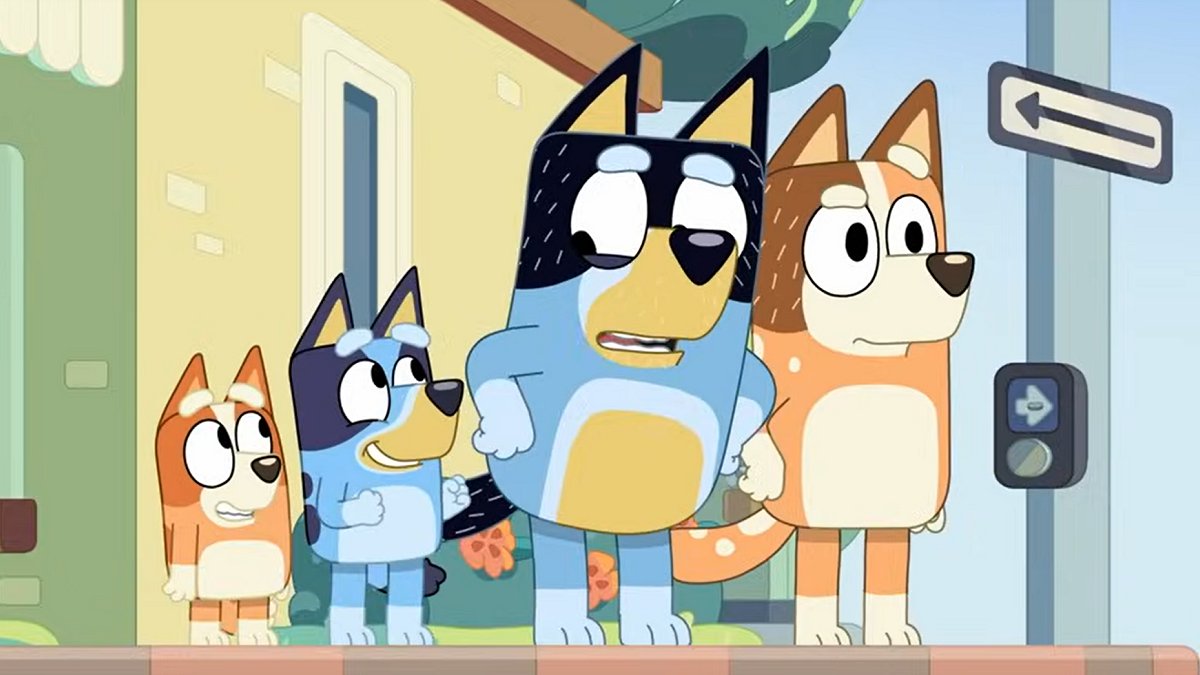

- [ July 10, 2024 ] VIP Pub Quiz: Where Trivia Titans Clash! Articles
- [ July 9, 2024 ] Badge of the Week: Long Walk to Freedom Badge News
- [ July 8, 2024 ] SporcleCon 2024 Shuttle Schedule Guide Articles
- [ July 8, 2024 ] Sporcle Events Newsletter Bonus Questions – Week of 7/8/24 Articles
- [ July 7, 2024 ] A Little More – Week of 7/1/24 Articles
Star Trek Uniform Colors – What Do They Mean?
Space…the final frontier.
In 1964, Gene Roddenberry pitched his idea for a space-age Western to NBC. His hope was to create a science fiction series that was like “Wagon Train to the stars,” but he also wanted the show’s content to reflect some of the very real problems that were plaguing Earth at the time. He felt the show had the potential to provide viewers with a realistic glimpse into a more utopian society, one which he thought was possible for humanity if they could learn some lessons from the past.
In 1966, his vision came to fruition when Star Trek first hit the airwaves. Over time, the show would go on to earn high praise for its cultural influence. The Original Series featured one of TVs first multiracial casts, one that also portrayed women in working roles, and many have cited Star Trek as being the inspiration, at least in part, to some of the technologies we have today, like cell phones and computer tablets. We even have a new way of speaking to each other thanks to Star Trek with the creation of Klingon , the world’s most popular fictional language.
The attention to detail Roddenberry brought to creating his fictional universe was immense, and while he may have helped inspire the iPad, not everything from Star Trek has caught on just yet. Apparently, his vision of a more utopian future also included velour tops, spandex jumpsuits and plastic. Something tells us we still have a ways to go before we start seeing fashion models walking down the catwalk dressed like Worf.
While the Star Trek uniform colors might seem highly illogical , that doesn’t mean they actually lacked that same awareness Roddenberry used elsewhere in the series. In fact, a lot of thought went into the costume design. The colors and insignia on each uniform can actually be quite telling.
It turns out there is a reason you should avoid wearing a red shirt during exploration missions.
To Boldly Go Where No Costume Designer Has Gone Before
To stay in line with his vision of a realistic future, Roddenberry wanted crew members of the Enterprise, the fictional star-ship of the series, to have realistic jobs and job titles. They used the US Navy as a guide, creating comparable ranks and job structures. There was a commander, a handful of lieutenant commanders, lieutenants, and numerous other roles. The various positions were eventually learned by viewers throughout the course of the show, but it was the uniform colors that gave the real hints as to who does what on Enterprise.
The Starfleet did not have randomly assigned uniform colors. Each color actually represented one of the ship’s various jobs and service roles. Here’s a quick breakdown on the Star Trek uniform colors from the Original Series:
- The command division wore gold shirts. This includes Captain Kirk, Lieutenant Sulu, and Pavel Chekov.
- The science and medical staff wore blue shirts. This includes Lieutenant Commander McCoy and Commander Spock.
- The engineering and communications division wore red shirts. This included Chief Engineer Scotty and Communications Officer Uhura.
- The security division also wore red shirts. You might know these people as the careless supporting characters that are immediately killed whenever the crew is confronted by a new enemy. We told you to avoid them.
This all gets a little messy in later Star Trek series. In The Next Generation, for example, command staff wore red and it was the engineering and security staff that wore yellow. Each new Star Trek movie that comes out further complicates things. Costume colors switch in almost every new adaptation.
Sleeve stripes highlighted the rank of crew members. The meaning of these has also changed throughout the course of the franchise. Generally speaking, the more stripes one had on their sleeve, the higher ranking they were. So captains often wore two or three stripes, while other enlisted officers might only have a single stripe.
Gold Is The New Green
Now for the really confusing part. Remember how Captain Kirk and crew wore those gold command shirts?
The Star Trek uniform colors were originally supposed to be red, blue and green. If you pay close attention, you’ll see this was the case. Captain Kirk’s outfit was actually more of a lime green when he was on set, but under bright studio lights, it appeared gold on film. As Star Trek costume designer William Theiss describes , “It was one of those film stock things. It photographed one way – burnt orange or a gold. But in reality was another; the command shirts were definitely green.”
Despite gold being canonized in later show dialog, when the lights are off, Kirk definitely shows his true colors.
Regardless of what color they were, one has to respect the vision and contributions that Star Trek has brought to the science fiction genre. Gene Roddenberry wanted everything in his fictional universe to have a specific purpose. While the series has had it’s share of highs and lows, one has to respect the attention to detail given. Just hope you never find yourself stuck wearing one of those red shirts.
Related Articles

The 20 Best Seinfeld Trivia Team Names
Following the misadventures of Jerry and his friends George, Elaine, and Kramer, Seinfeld was notable for its focus on the mundane, but relatable, aspects of life. It’s no wonder it’s been described as a “show […]

10 Easy Pun Costumes for Halloween
When’s the last time you laughed out loud at someone’s witch costume or just had to take a photo of someone in a skeleton suit? Probably never. When it comes to the best Halloween costumes, […]

The 20 Most Memorable TV Sitcom Catchphrases
A sitcom, which is short for “situational comedy”, is a TV show that follows the same group of characters around as they more or less attempt to “do life”. They are often funny in nature, […]
Copyright © 2007-2024 Sporcle, Inc.

Starfleet uniform

Starfleet uniforms in 2371, showing two separate styles in use at once
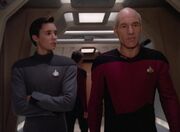
A provisional officer's uniform alongside a standard duty uniform
Starfleet uniforms were uniforms worn by individuals serving in the Federation Starfleet , originally a United Earth organization. These uniforms facilitated the wearers' needs as both scientists and researchers , as well as Starfleet's military role. The uniform and combadge used by Starfleet personnel may vary by the ship or facility they were assigned to, or the officer's rank or department. These were often retained even when visiting other Federation locations. ( TNG : " The Child "; DS9 : " Homefront ", " Tears of the Prophets "; LD : " We'll Always Have Tom Paris ", " Kayshon, His Eyes Open "; DIS : " Saints of Imperfection ")
Casual duty attire also allowed for considerable variation of uniform aboard a Starfleet vessel, though it was ultimately up to the captain's discretion. Wearers were expected to abide by the Starfleet dress code , though special exceptions were sometimes made for certain aspects of an individual's cultural heritage, such as Worf 's Klingon baldric , Nog 's Ferengi headdress , and the earrings of Ro Laren , Kira Nerys , and Shaxs . ( VOY : " Learning Curve ", et al.) According to Elim Garak , " I think Starfleet should allow their officers more latitude in accessorizing their uniforms. You'd be surprised what a nice scarf can do. " ( DS9 : " Broken Link ")
On two occasions, the term " Federation uniform " was used to describe Starfleet uniforms.
In 2369 , the Bajoran civilian Mullibok , who was being evicted from his home , asked Commander Benjamin Sisko how many Federation uniforms he planned on sending down to have him removed. ( DS9 : " Progress ")
In 2372 , Chakotay referred to his as a Federation uniform as he explained to Kar how it was like the Jal name that the Kazon earned. Chakotay told him that his uniform was earned through " years of study ", and " learning about science and ships and navigation , " adding too, that he was further taught to be "[..] prepared us to defend ourselves in battle. They prepared us very well. And we had to pass many difficult tests before we were given the right to wear the uniform. " ( VOY : " Initiations ")
- 1.1 Command
- 1.2 Operations
- 1.3 Sciences
- 2.1.1 Type #1
- 2.1.2 Type #2
- 2.1.3 Type #3
- 2.1.4 Type #4
- 3 Uniform variations
- 4 Dress uniforms
- 5.1.1 Design
- 5.2 Ambiguous uniform
- 5.3 External links
Divisions [ ]
Starfleet uniforms were classified by color among the command, sciences, and operations divisions. Occasionally, the uniforms were also broken down by department, while displaying rank insignia conspicuously. The color scheme had varied over time throughout Starfleet history, but the uniforms were designed for comfort even in the most extreme environments. ( DS9 : " Trials and Tribble-ations ", " Let He Who Is Without Sin... ")

Command [ ]
The command division was the head of Starfleet, with most of the ranking officers in Starfleet Command wearing these colors. Generally, this division was responsible for the administration of starships , starbases , and space stations .
Operations [ ]
The operations division was the backbone of Starfleet, encompassing the engineering , security , and support departments. This division was responsible for technological innovation and for maintaining and defending the Federation.
Sciences [ ]
The sciences division was the heart of Starfleet, composed of the exploratory , medical , and mental health departments.
Uniform styles [ ]
Unknown eras [ ].
These Starfleet uniforms were introduced between the 24th and 31st centuries .
Type #1 [ ]

A female officer in an unknown uniform
This uniform was worn by an operations division officer , as seen in a photo within the Transporter Facility maintained by Chief Petty Officer Carlton Dennis . ( LD : " Grounded ")
Type #2 [ ]
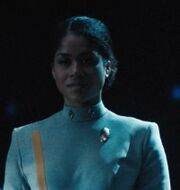
A female junior officer in a uniform from an unknown era
This uniform was worn by one of Tal 's hosts . ( DIS : " Forget Me Not ")
Type #3 [ ]
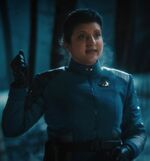
A holographic representation of a female lieutenant
This uniform was worn by officers in an unknown era. ( DIS : " Su'Kal ")
Type #4 [ ]
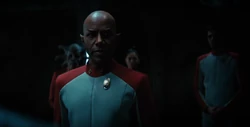
Holographic representations of officers in uniforms from an unknown era
This uniform was worn by the delegation welcoming the Kelpien and Ba'ul Alliance into the Federation. ( DIS : " Su'Kal ")
In the 23rd century , similar uniforms had been in use as cadet outfits. ( DIS : " Through the Valley of Shadows ")
Uniform variations [ ]
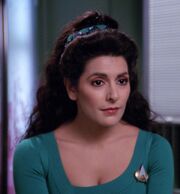
Troi in her casual attire
Some officers wore alternate uniforms. Deanna Troi often wore casual clothing while on duty, and T'Pol retained her original Vulcan uniform with a few concessions to her Starfleet rank and ship assignment. Other officers, such as Worf, Montgomery Scott , and Ro Laren, were allowed to wear accessories relating to their culture with their uniforms, but this was at the discretion of the captain. Uniforms were also altered to accommodate non-humanoid officers, such as the three-armed, three-legged uniform of the Edosian Arex , and the uniforms for beluga whales Kimolu and Matt . ( ENT : " Borderland "; Star Trek II: The Wrath of Khan ; TNG : " Ensign Ro "; TAS : " Mudd's Passion "; LD : " First First Contact ")
Uniforms were also adapted to environmental or atmospheric conditions. When exploring the planet Tyree , Benjamin Sisko and colleagues wore long, flowing gown uniforms to deal with the sand . They featured a colored stripe to represent departments. ( DS9 : " Shadows and Symbols ")
Dress uniforms [ ]
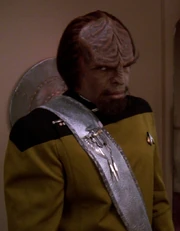
Worf wearing his dress uniform with a Klingon ceremonial sash
Dress uniforms were a variant of the standard Starfleet uniforms worn for special occasions, such as weddings , courts martial , funerals , and the greeting of ambassadorial delegations and heads of state. ( TOS : " Court Martial ", " Journey to Babel "; TNG : " Lonely Among Us ", " Manhunt ", " Data's Day "; DS9 : " Move Along Home ", " Rules of Engagement "; VOY : " Course: Oblivion ", " One Small Step ", " Ashes to Ashes "; Star Trek: Insurrection )
A pair of dress uniform boots worn by Patrick Stewart was sold off on the It's A Wrap! sale and auction on eBay. The pair shows that the legs were completely covered and the boots were kept on by a harness. [1]
Appendices [ ]
Background information [ ].
Patrick Stewart 's character of Jean-Luc Picard has appeared in more styles of Starfleet uniform than any other character on screen without story contrivances (like time travel , holodecks , or alternate timelines ) being involved.
For most of Star Trek 's history, Starfleet uniforms have had at least three division colors. Some characters have worn different division colors in different episodes. Leslie , Jae , Tom Paris , Harry Kim , and Sylvia Tilly have each been shown wearing three colors at different points (including, for Paris and Kim, alternate timelines and holodeck scenarios); however, the first character to wear all three division colors in one episode was Ensign Sam Rutherford , who wore operations gold, command red, and medical blue in LD : " Envoys ".
The Starfleet uniforms worn during Star Trek: The Original Series were designed by William Ware Theiss , who returned to design the Star Trek: The Next Generation uniforms (which were further adapted into future versions on Star Trek: Deep Space Nine , Star Trek: Voyager , and the TNG -era films by Robert Blackman ). Robert Fletcher designed the uniforms seen throughout the original series movies, with later new designs provided by Nilo Rodis .
Robert Blackman also designed uniforms worn on Star Trek: Enterprise , a design representing a precursor to those seen in TOS . The uniforms seen in Star Trek: Discovery were designed by Gersha Phillips . The uniforms in Star Trek: Picard were designed by Christine Clark .
Michael Kaplan designed the uniforms seen in Star Trek and Star Trek Into Darkness , and Sanja Hays designed the uniforms for Star Trek Beyond .
As shown in the It's A Wrap! sale and auction , a number of Starfleet uniforms have had padding to increase muscular appearance. Such cases include two costumes for Tom Paris , one racquetball costume for Julian Bashir , and a Deep Space Nine costume for Worf, to create a more Klingon appearance. According to Wil Wheaton , all the main cast members wore muscle padding during the first two seasons of The Next Generation , mainly because of the tight-fitting nature of the spandex uniforms used in these two seasons. [2]
Several prototype uniform undershirts to those seen in Star Trek II: The Wrath of Khan on were sold off on the It's A Wrap! sale and auction on eBay. [3]
Ambiguous uniform [ ]
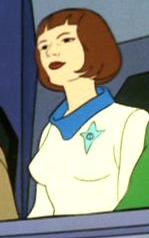
Female on the Elysian Council
A Human female seen as a member of the Elysian Council in " The Time Trap " wore a uniform of ambiguous origin. It was described in the Star Trek Concordance as "a white suit with blue collar and an insignia on the left breast," and was suggested to "possibly [be] an early Star Fleet [sic] uniform". While it is known that the Bonaventure , and possibly other Earth/Federation ships, were lost in the years prior to 2269, it is unclear if this is indeed a Starfleet uniform, and, if so, from which era it originated.
External links [ ]
- Starfleet uniform at Memory Beta , the wiki for licensed Star Trek works
- 22nd & 23rd century Starfleet uniforms at Ex Astris Scientia
- 24th century Starfleet uniforms at Ex Astris Scientia
- Starfleet uniforms at Spike's Star Trek Page
- Interview with William Ware Theiss at Phaser Resource (X)
- 1 USS Voyager (NCC-74656-A)
- 2 Daniels (Crewman)
- 3 Star Trek: Prodigy
- Stranger Things
- The Lord of the Rings

From TOS to Star Trek Beyond: The Evolution of Uniforms
From its humble – and somewhat precarious – beginnings in 1966, Star Trek’s place in science fiction has grown to epic proportions, unmatched by others in its genre (which, of course, is a bone of contention).
Arguments aside, there’s one constant element in Star Trek that we cannot do without: their wonderfully designed uniforms. I have to admit – there’s not much sexier than a person in uniform. Especially if they’re in Star Trek.
I’m not saying outlandish alien features and costumes don’t add to a story’s appeal, but Star Trek’s crew members – from TOS to Star Trek Beyond – hit the spot with their simple but “look at me” vibe.
So, how well do you know your Star Trek uniforms?
If your memory is a little hazy, let’s help you with that. Here is a Star Trek uniform guide which showcases the threads from The Original Series, The Motion Picture, The Next Generation, Generations, Deep Space Nine, Voyager, Enterprise, and the most recent movies.
Perfect timing for Star Trek Beyond, don’t you think?

Which uniforms do you like best?
Related: Which Star Trek Villain Are You?
Gaming Trailers
More like this.

Rocket League | Star Wars Droids Gameplay Trailer
Latest trailers.
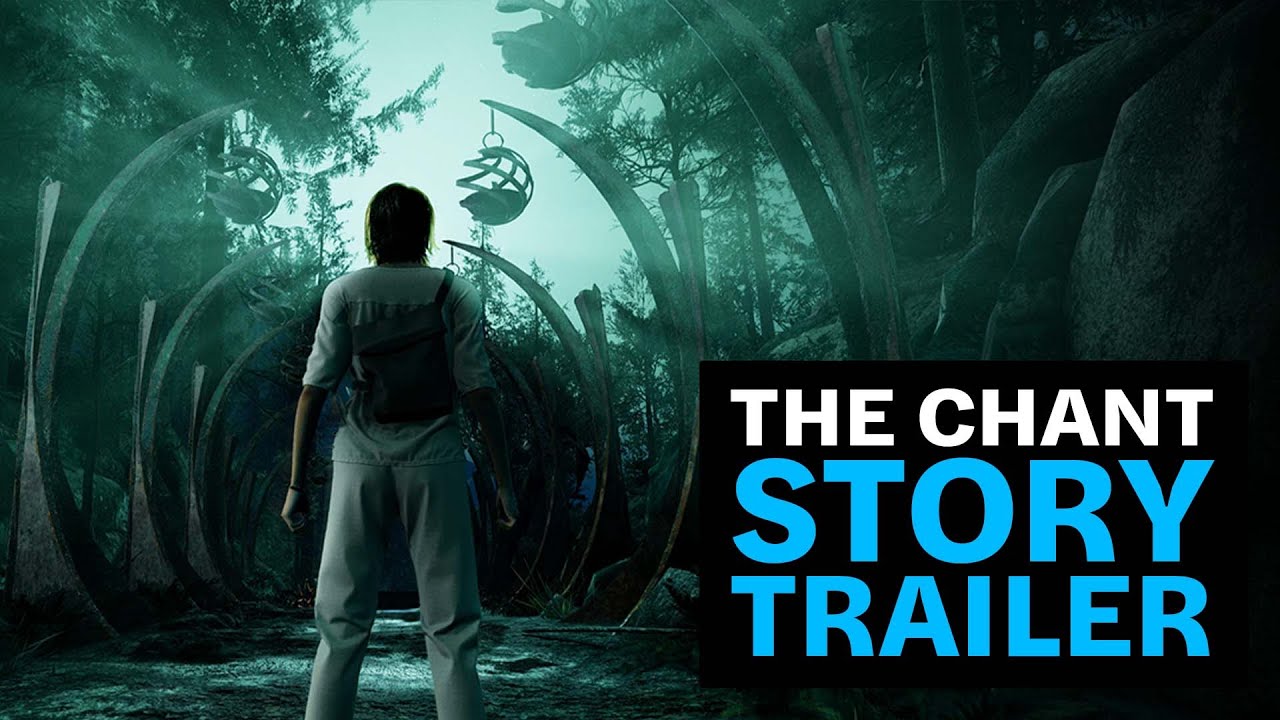
The Chant | Story Trailer
Star Trek: 10 Secrets Of The Next Generation Uniforms
Everything you need to know about Star Trek: The Next Generation's Starfleet issue duds.

Arguably as recognizable as The Original Series' color-coded "pajamas" are in pop culture today, Star Trek: The Next Generation's Starfleet uniforms are a distinct part of Star Trek's unique vision of the future.
Originally designed by William Ware Theiss (and notoriously modified by Robert Blackman), Star Trek: The Next Generation's uniforms are deceptively simple creations. Dubbed "spacesuits" by the cast of TNG, these uniforms are more than just lycra spandex and/or wool gabardine television costumes.
TNG's Starfleet uniforms evolved over the course of its seven season run, been the subject of their own real world controversies and production problems, and inspired future generations of costuming – appearing as recently as Star Trek: Picard's first season and Star Trek: Discovery's third season.
Like Star Trek's many famous starships, its props, its sets, its aliens, its fictional history, Star Trek: The Next Generation's uniforms have their own lore and their own secrets.
From the inspirations of Wesley Crusher's acting ensign uniform (which never fully zipped up in the back for some reason) to the iconic and progressive skant to Starfleet-issue jockstraps, we've unfolded ten secrets of Star Trek: The Next Generation's Starfleet uniforms that you need to know (before you get suited up for your next convention appearance).
10. Starfleet Stank

Star Trek: The Next Generation's first take on the 24th century's Starfleet uniforms were formfitting and sleek, with bold color blocking reminiscent of The Original Series' iconic look. However, in order to conform to designer William Ware Theiss' strict "no wrinkles" rule, these costumes were held taught with stirrups that looped under the actors' boots and pulled down on their backs.
The discomfort associated with these early costumes is much storied in the legacy of Star Trek: The Next Generation and fodder for numerous tales told by the actors at Star Trek conventions. Jonathan Frakes even claimed to have "ripped more than one of them off in frustration." In at least one telling of the horrors of those uniforms, Patrick Stewart stated that the uniforms caused so much back pain that his chiropractor suggested he sue the producers.
Less talked about, however, is the smell.
TNG's OG uniforms were constructed out of lycra spandex, a material not know for its breathability. According to Theiss' successor, Robert Blackman:
There was no give in the shoulder and there was this constant pressure on the actors who were wearing the costumes for twelve to fifteen hours a day. They were very, very much disliked by the actors – uncomfortable to wear, hot, and they retained body odor.
So along with cat poop in corridors , the uniforms also apparently smelled. The set of USS Enterprise-D must've been Hollywood magic.
I played Shipyard Bar Patron (Uncredited) in Star Trek (2009).
Why Star Trek's Ever-Changing Uniforms Are More Than Just Style Choices
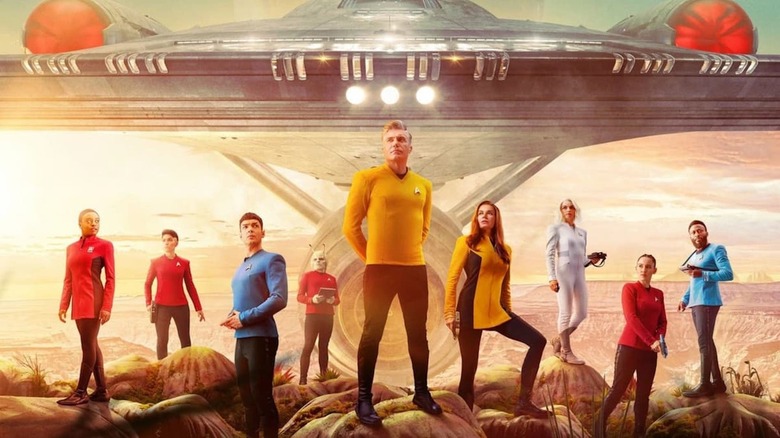
This post contains spoilers for the season finale of "Star Trek: Strange New Worlds."
The first-season finale of "Star Trek: Strange New Worlds," called "A Quality of Mercy," arrived on Paramount+ today, ending what may be the finest first season in "Star Trek" history (Trek shows all notoriously get off to rocky starts ). The final episode, rife with fan service, sees Captain Pike (Anson Mount) confronting his future self and visiting the "Original Series" era via a magical widget called a Klingon time crystal. Pike's future self — coming from a timeline where a great Romulan war is raging — offers present-day Pike an opportunity to visit a period seven years hence where he will have the opportunity to prevent said war from ever starting. As it so happens, that period is the original "Star Trek" episode "Balance of Terror" from 1966, only with Pike serving as captain instead of Kirk (It should be noted that "Strange New Worlds" takes place nearly a decade prior to the events of "Star Trek").
When Future Pike arrives to tell Present Pike about the possibility of a future timeline, he appears in a red nautical uniform with a pull-across breast flap, an over-the-shoulder clasp, and a small, white collar. This is the uniform first seen in " Star Trek II: The Wrath of Khan ," and which persisted throughout the following four Trek feature films. The uniform was a chronology-appropriate reference to the way Starfleet uniforms change over time, and was an instant indicator — in addition to Anson Mount's age make-up — of when exactly this new Pike was visiting from.
The frequent rotating of uniforms
Sticklers for continuity — and all good Trekkies are likely sticklers for continuity — might point out that the frequent changes of uniform may not make a lot of sense for a military organization like Starfleet. Starfleet is frequently depicted as being devoted to order and fostering its crew's esprit de corps, and devotion to a certain orderly status quo is one of the tenets of the organization.
It's jarring to a Trekkie's eye to see multiple kinds of uniforms occupying the same bridge at any given moment. In the original "Star Trek," the female officers wore miniskirt uniforms, a sexist trope that "Next Generation" tried to take the curse off of by depicting male officers wearing them as well. While the effort was appreciated, it was too little too late, and a universal uniform was eventually settled on. Especially jarring was the mixture of uniforms seen in the 1994 film "Star Trek: Generations" which featured several characters wearing the color-coded departmental uniforms as they appeared on " Next Generation ," but several others wearing the colored-shoulder-grey-turtleneck uniforms that first appeared on "Star Trek: Deep Space Nine." Did "Generations" take place during a strange, brief transitionary period in Starfleet when either uniform was okay?
The changes in uniform, while perhaps the most logical thing in terms of continuity, do make sense from a dramatic perspective: A viewer will be able to tell at a single glance what era the characters are living in . Pike wearing a uniform from the classic movies immediately communicates to the uninitiated that he is from a time far away enough for the uniforms to have changed, and to the initiated that he is from close to 27 years in the future when "Wrath of Khan" takes place.
Keeping it all straight
Ever since the debut of "Star Trek: Deep Space Nine" in 1993, it became acceptable for multiple "Star Trek" shows to run simultaneously. "Deep Space Nine" overlapped with "Star Trek: The Next Generation" for a time, and then shared " Star Trek: Voyager " airspace for multiple seasons. Since Trek is largely about Starfleet, military vessels, and people in uniform ("Star Trek" is, above all, a workplace show), all the characters in any series have to wear the same thing, especially if they take place in the same timeline the way NextGen, DS9, and "Voyager" did. However, in order to distinguish the three shows, the uniforms were slightly different.
The NextGen uniforms were the standard, with the DS9 uniforms appearing to be assignment-based; perhaps deep space assignments warranted a new look. The USS Voyager took on that look, and DS9 changed to a uniform with grey shoulders and department-colored collars. The grey-shoulder look would also carry into future NextGen movies. "Voyager" kept the grey-neck look throughout its run, as they were 75 years away from home and couldn't get the orders to change outfits.
With only the three active Trek shows/movie series running, the uniform shifts were easy to track. This has become more difficult in the Paramount+ era, when the franchise's timelines are splayed all over Trek continuity, and there are more shows than ever shows running simultaneously.
Seven at once
To establish something of a brief timeline of the newer Trek programs: the first two seasons of "Star Trek: Discovery" take place about a decade prior to "Star Trek." "Star Trek: Strange New Worlds" takes place immediately after the second season of "Discovery." Meanwhile, " Star Trek: Lower Decks " takes place after the events of the 2002 movie "Star Trek: Nemesis," and characters from NextGen appear regularly. The first season of " Star Trek: Prodigy " takes place concurrently with the third season of "Lower Decks." " Star Trek: Picard " takes place about 18 years after "Prodigy." Then, just to muddy the waters further, the third and fourth seasons of "Discovery" take place in the distant 32nd century.
Now that no one is confused, let us move on.
Looking over the above list, there would need to be seven distinct looks invented. One for each era of Starfleet, and for each notable ship (it's been established that some ships wear different uniforms than others, again presumably as a way to denote the nature of their assignments). The USS Discovery began with blue/silver jumpsuits and boots, and had to change into a new era's uniforms when arriving in the distant future. "Strange New Worlds" features a subtle update of the 1966 uniforms (and even then, were updated slightly from their initial appearance on "Discovery"). The crew of the USS Cerritos on "Lower Decks" wear a NextGen-adjacent look, while the teens on the USS Protostar in "Prodigy" have something more akin to Pike's "Khan"-era uniform. "Star Trek: Picard" mostly takes place out of Starfleet's purview, so the uniforms aren't as common, giving the show its own unique, civilian look.
And none of this addresses formal uniforms, standard athletic uniforms, away mission jackets, medical uniforms, etc. etc. etc.
Across the centuries
The above breakdown of "Star Trek's" timeline reveals that Trek, unlike other sci-fi franchises, offers a very distinct, recorded history and chronology. "Star Wars" fashion, in contrast, seems to be weirdly stable over its generations, with only Stormtrooper outfits changing from time to time to denote the era. "Star Trek," in frequently rotating uniforms, creates not just visual variety between its multiple, concurrently-running shows, but a solid, visual timeline of Starfleet history. When Pike shows up in "Khan"-era uniforms, we know when that's from. Thanks to the NextGen episode "Tapestry," audiences know that those uniforms were in use at least until when Captain Picard was a young man.
The uniforms are also often used to show that time is out of joint. When Kirk finds himself in a dark mirror universe , his outfit is immediately different. When Worf begins slipping between parallel dimensions, the communicators change. When an alternate future is shown in "Future Imperfect" or "All Good Things...," the uniforms serve as the instant indicator that reality has been rent asunder. Costume design is being used to communicate time, place, and mood. There is an efficient brilliance to that.
Because of the sheer volume of current Trek, it can seem like Starfleet is playing a little fast and loose with their traditions of formality. But the frequent uniform redesigns serve both a story function as well as a taxonomic function, and can serve as guideposts in case the audience gets a little lost or overwhelmed. The uniforms will be the familiar things we can latch onto.
Why Deanna Troi Wore a Starfleet Uniform in TNG's Final Seasons

Your changes have been saved
Email Is sent
Please verify your email address.
You’ve reached your account maximum for followed topics.
Quick Links
Deanna troi's starfleet uniform, explained, how marina sirtis felt about deanna troi's new uniform, deanna troi almost wore a different starfleet uniform, giving deanna troi a starfleet uniform wasn't enough for sirtis.
- On Star Trek: The Next Generation , Counselor Deanna Troi wore uniforms different from those of the rest of the USS Enterprise crew.
- In the pilot episode, Deanna Troi was seen in the Starfleet skant, which actor Marina Sirits called "the cosmic cheerleader" outfit.
- However, near the end of Star Trek: TNG, Deanna Troi starts to wear a Starfleet uniform with good reason to do so.
One of the most underappreciated characters on Star Trek: The Next Generation was the newest addition to the Enterprise's bridge crew. Recognizing the importance of mental health, a counselor was added to the cast of Starfleet officers. Yet, Deanna Troi rarely wore a Starfleet uniform until the final seasons of The Next Generation , and the reason is surprising. Interestingly, despite spawning three sequel series, no other Star Trek series of the era included a ship's counselor, making Troi unique.
The real-world reason for Deanna Troi's penchant for civilian attire was lower-minded than Star Trek is supposed to be. Given the full-body costumes, there was little in the way of showing skin among the cast. Skimpy outfits for series regulars and guest stars were very common for Star Trek: The Original Series . However, the late 1980s and 1990s were different times. The new costumes provided a way for producers to add some "sexy" to the bridge, and it came via the low-cut, skin-tight outfits actor Marina Sirtis was forced to wear. The in-universe rationale, however, makes sense. The USS Enterprise-D was a ship with a crew complement of more than a thousand people, civilians, and children. The Starfleet uniform is a symbol of authority, so Troi wore civilian clothes, without rank, to make people feel more comfortable . Yet, that symbol of authority inspired her to wear only Starfleet uniforms later while on duty in The Next Generation Seasons 6 and 7.
Updated by Joshua M. Patton on July 3, 2024: By allowing her to wear a Starfleet uniform, the characterization of Deanna Troi was expanded, though the actor wished for a more complete and involved backstory. Instead, Troi was primarily defined by her relationship with Will Riker. While this is one of Star Trek's best romances, the character deserved more. This article has been updated to comport to CBR's current formatting standards.
10 Most Memorable Star Trek TNG Episodes, Ranked
Star Trek The Next Generation revived audiences by boldly going where no one has gone before with some truly memorable episodes.
In the series pilot episode, Deanna Troi wears the "skant," a mini-skirt uniform worn by both men and women. "I was dressed as the cosmic cheerleader...[i]magine a potato with matchsticks sticking out of it," Sirtis says in The Fifty-Year Mission: The Next 25 Years: From The Next Generation to J. J. Abrams: The Complete, Uncensored, and Unauthorized Oral History of Star Trek by Edward Gross and Mark A. Altman. After that episode, however, she sticks to civilian clothes, though the actor didn't find these outfits any more flattering. It wasn't until the two-part episode "Chain of Command" in Season 6 that she finally got her Starfleet uniform.
In the episode, Ronny Cox guest starred as the infamous Captain Jellico, given command of the Enterprise while Captain Picard went off on a secret mission. Jellico's brusque style contrasted in many ways with Picard's, causing severe friction with First Officer Will Riker . As Counselor Troi tries to explain to Jellico why the crew is resisting his many commands, he tells her to start wearing her uniform . He appreciated "formality on the bridge." After this episode, Troi is rarely seen out of uniform. While some might suggest it was Jellico's influence, Troi started this journey a season earlier.
The Season 5 episode "Disaster" involved a massive power outage on the Enterprise. Troi is the senior officer on the bridge and has to take command. Despite problems with how the character was written, "Disaster" is an excellent episode for Troi. She's uncertain in her role, and the officers under her command challenge her decisions. A member of the empathic Betazoid species, Troi uses her emotions in command, going with the orders that "feel" right. During "Conundrum," a later Season 5 episode where everyone loses their memories, she's the only one who notices something is wrong.
A Season 7 episode of The Next Generation , "To Thine Ownself," potentially explains why Troi stayed in uniform. She mentions her brief time in command as an exciting challenge. So, she decides to go up for promotion to full Commander. While she never mentions the Starfleet uniform, if Deanna Troi wanted to lead, she needed the authority a uniform provided . She still wore civilian clothes while off-duty, but once in uniform, the ship's counselor became a more involved crew member. This continued into the movies, where she donned the new grey and black uniform introduced in Star Trek: First Contact . However, Troi sticks to civilian clothing in Star Trek: Picard until she gets one of the leather Starfleet field jackets the rest of the crew wear.
Why Star Trek V: The Final Frontier's Visual Effects Were So Bad
Star Trek V: The Final Frontier has a bad reputation among fans, but the film's biggest problems were its visual effects and the problems behind them.
The creation of Deanna Troi is one of the Star Trek: Phase II ideas in The Next Generation , recycled by Gene Roddenberry. The character of Ilia, a Deltan, was used in The Motion Picture , and Troi was her replacement. The Betazoid abilities were supposed to be more than mere empathy, specifically manifesting in an increased libido. The character was supposed to have three breasts, though writer Dorothy "D.C." Fontana talked Roddenberry out of that. While it seems sexist now, it's equally possible it was a misguided attempt to challenge the moral conventions of the time about women and sex. Just as skants provided an updated version of The Original Series ' miniskirt but subverted expectations being worn by both men and women.
Still, as far as Sirtis was concerned, Deanna Troi's characterization improved once she donned a Starfleet uniform . "I was thrilled when I got my regulation Starfleet uniform," she told the BBC in 2001 , "consequently, I got all my brains back because when you have a cleavage, you can't have brains in Hollywood." Once she was in uniform, Troi would go on away missions, use phasers, and participate in more action-oriented scenes than before. Even still, Sirtis may be selling the early seasons of Troi a little short. While not always written powerfully, her character has always been a vital part of the crew in the eyes of both fans and her castmates.
Whether in uniform or more revealing civilian clothes, Deanna Troi is a remarkable character. She is the show's most compassionate and caring character, save perhaps for Whoopi Goldberg's Guinan. With her deep concern for people, she carved out a place for herself among leaders, warriors, and scientists. At its core, that is what Star Trek is supposed to be about. However, the change affected Sirtis, and her performance as Troi only strengthened once she started looking like a true member of Starfleet .
Star Trek: The Picard Maneuver, Explained
Among his other accolades, Jean-Luc Picard has a military maneuver named after him, and it appeared early in Star Trek: The Next Generation's run.
While Marina Sirtis appreciated wearing what the cast calls "the spacesuit" more than civilian attire, she almost wore a uniform of a different color. When Star Trek: The Next Generation was still in the casting process, Sirtis auditioned for the role of security officer Tasha Yar. Meanwhile, model and actor Denise Crosby read for Troi. It was series creator Gene Roddenberry who made the call for the two actors to switch roles.
According to The Fifty-Year Mission, an oral history of Star Trek , producers "selected [Denise Crosby and Marina Sirtis] for the opposite roles, and Gene said, 'I want Crosby to play Tasha and Marina to play Troi.'" Crosby was ultimately killed off near the end of the first season because, as Crosby reveals in the same book, she felt her character was being under-utilized, but she was forced to stand on the bridge for long hours on shooting days. Crosby would return for two episodes later in the run, however.
Troi's character underwent many changes during the development process , but she was always meant to be the counselor. Some writers, like Brannon Braga, felt the character didn't make sense, especially given the "Roddenberry Box," a set of rules declaring Starfleet officers don't have petty disagreements, fights, or jealousy. Despite writing some of the best Star Trek episodes across the franchise, a counselor was essential.
The ship is often in dangerous and traumatic situations, so it makes sense that the crew and civilians aboard would need someone to talk to. Consulting producer David A. Goodman credited the show and character "for making therapy palatable for a whole new generation" in The Fifty-Year Mission . Her seat on the bridge was meant to reinforce her importance as a member of the Bridge crew.
“The Star Trek Universe Is in Very Good Hands” Jonathan Frakes Bids Farewell to Star Trek: Discovery
In an interview with CBR, Star Trek legend Jonathan Frakes talks about taking the director's chair one last time for Star Trek: Discovery Season 5.
By allowing Deanna Troi to wear a Starfleet uniform and seek promotion, The Next Generation storytellers gave the character more depth than she had previously. Yet, this late interest in her career wasn't enough for Marina Sirtis, at least in hindsight. At the Showmasters Comic-Con in 2023, Sirtis explained what she felt the character of Troi lacked. "In a general way, I'd have liked to known more about her," she said. "I always used to say, 'We know she's got a crazy mother, and that she's from Betazed and that she likes to work out in the ugliest leotard ever known to man...we know nothing [else] about her." The only other detail viewers got about Troi's past was her relationship with her "Imzadi," Riker.
When Deanna Troi returned for Seasons 1 and 3 of Star Trek: Picard , she was no longer an active member of Starfleet. She married Riker in Star Trek: Nemesis , and the couple had two children. There was Kestra, named after her deceased sister and Thad, who died of an incurable disease. She did serve with Riker while he was the captain of the USS Titan, but after that, she became a wife and mother. However, the Picard series finale showed she still worked as a counselor, in a humorous scene where she helped the nearly-human Data work out his new feelings. Still, Troi never got the kind of backstory or development characters like Worf or Beverly Crusher did .
Deanna Troi is an iconic Star Trek hero , no matter what uniform she's wearing, a Starfleet spacesuit or the goofy gray and pink workout outfit. The decision to allow Troi to wear a proper uniform and take on more command responsibility was, arguably, long overdue by Season 6. Yet, the writers struggled to live up to Troi's potential. She was supposed to be as intelligent as Spock, after all. Still, Sirtis was able to elevate the material and, thereby, Troi herself through her remarkable and heartfelt performance.
Star Trek: The Next Generation
*Availability in US
Not available
Set almost 100 years after Captain Kirk's 5-year mission, a new generation of Starfleet officers sets off in the U.S.S. Enterprise-D on its own mission to go where no one has gone before.

Star Trek: DS9s Odo: Full Name And Meaning Explained
- Odo's full name is Odo'ital, meaning "nothing," given by Bajoran scientists and a Cardassian overseer.
- Odo dropped the surname "Ital" after finding meaning and identity through friendships on Deep Space Nine.
- The story of Odo's name is revealed to the Female Changeling, not Kira, in "Heart of Stone."
It's not mentioned often, but Star Trek: Deep Space Nine 's Constable Odo (Rene Auberjonois) actually had a full name that he chose not to use. Discovered in his liquid state in orbit above Bajor, Odo spent a large part of his life before DS9 enduring a battery of painful laboratory tests. The experiments were conducted by Bajoran scientist Dr. Mora Pol, played by James Sloyan , who was unaware that Odo was a sentient being. When Odo eventually signaled his sentience to Pol, the two worked together so that the Changeling could maintain a solid form.
After Odo and Mora Pol parted, the Changeling became a security officer on the Cardassian space station Terok Nor . There, he befriended Kira Nerys (Nana Visitor) and met his arch-nemesis Quark (Armin Shimerman). All three stayed aboard the station after the Cardassian Occupation ended, becoming integral parts of Deep Space Nine's crew, under the command of Benjamin Sisko (Avery Brooks). However, while the Constable was introduced to his new Federation colleagues as Odo, he later revealed that this was a shortening of his longer name, which had previously been a tragic reminder of his abandonment.
Constable Odo's 10 Best Star Trek: DS9 Episodes
Constable Odo's best Star Trek: Deep Space Nine episodes showcase the search for his origins, his clashes with the Founders, and his love for Kira.
Odos Full Name In Star Trek: DS9 Explained
"odo ital, which eventually got shortened.
In Star Trek: Deep Space Nine season 3, episode 14, "Heart of Stone", Odo tries desperately to save Kira's life when she becomes trapped in an expanding rock formation. To keep the Major's spirits up, he decides to tell Kira the story of how he got the name Odo. Discovered as an unknown sample, Odo was labelled as such by Dr. Mora, and this label was translated by Bajor's Cardassian occupiers , the Cardassians into the name, Odo'ital , as he explains below:
Odo'ital literally means the word 'nothing'. Even after it became clear that I was sentient, the Bajoran scientists kept calling me that. As a joke, they split it into two words like a Bajoran name, Odo Ital, which eventually got shortened
The Odo'ital name, and even its Bajoran translation, is a pretty bleak example of how little agency Odo had during his time with Dr. Mora Pol. Even when they knew that he was sentient, they continued to effectively refer to Odo as " nothing ", which while being very Cardassian, doesn't reflect all that well on the Bajorans either. For context, Odo being named Odo Ital by the Bajorans and Cardassians is essentially like calling a human male John Doe, a name that is intrinsically linked with a lack of identity.
The ending of "Heart of Stone" reveals that Odo has been talking to the Female Changeling, and not Kira, meaning she never hears this story.
Why Odo Dropped His Surname In Deep Space Nine
"i no longer think of myself as nothing.".
Touchingly, Odo reveals that through his friendships with his fellow Star Trek: Deep Space Nine characters , he was able to reclaim his name for himself. The friendships that Odo makes aboard DS9 finally meant that he no longer saw himself as " nothing ", which is why he ultimately dropped the " Ital " in " Odo Ital " . Odo explains this beautifully in "Heart of Stone", in one of many great DS9 performances by Rene Auberjonois:
And then I met you. And the others. Sisko, Dax, even Quark. And now, when I hear one of you call me Odo, I no longer think of myself as nothing. I think of myself as me.
Given that Odo is actually talking to the Female Changeling (Salome Jens) this is an extremely pertinent admission. The Female Changelings plan in "Heart of Stone" is to discover what it would take to get Odo to return to the Great Link. Over the course of her conversations with Odo, the Female Changeling discovers that nothing she can do will break the bond that Odo has with the crew of DS9. The characters in Star Trek: Deep Space Nine gave Odo a sense of belonging that his own people denied him, and finally allowed him to become his own person; an individual who defied the Dominion's tyranny.
Star Trek: Deep Space Nine
Cast Terry Farrell, Cirroc Lofton, Rene Auberjonois, Nicole de Boer, Michael Dorn, Andrew Robinson, Nana Visitor, Avery Brooks, Colm Meaney, Armin Shimerman, Alexander Siddig
Release Date January 3, 1993
Genres Drama, Sci-Fi, Action, Adventure
Network CBS
Streaming Service(s) Paramount+
Franchise(s) Star Trek
Writers Ira Steven Behr, Michael Piller, Ronald D. Moore
Showrunner Ira Steven Behr, Michael Piller
Rating TV-PG
Where To Watch Paramount+

Prodigy’s Shocking Ending Connects (Nearly) All of Modern Star Trek Canon
Let’s dig into the memory banks.

The biggest Star Trek binge in franchise history has arrived. Netflix dropped all 20 episodes of Star Trek: Prodigy Season 2 on July 1 , which led to a shocking and surprisingly open-ended finale. In addition to a time travel plot and a guest character who connects Prodigy to several other eras of Star Trek, the last episode, “Ouroboros Part II,” also syncs up with several major plot points from Star Trek: Picard . In fact, Prodigy’s finale helps make various aspects of Picard more explicable in the tapestry of modern Trek.
Here’s what the final moments of Prodigy mean for the Star Trek timeline, and how the show is set up for a hypothetical Season 3. Spoilers ahead.
Prodigy Season 2’s ending sets up Picard Season 1

The new crew of yet another new starship.
After defeating the Loom and Asencia, Gwyn, Rok, Dal, Jankom, Zero, Ma’jel, and Murf all find themselves back at Starfleet Academy. Finally, it looks like Star Trek’s Boxcar Children will get their happy ending, but no. It’s First Contact Day 2385, and as everyone in Starfleet celebrates, longtime fans know what’s coming. In Picard Season 1, April 5, 2385, is when Synths go rogue and attack the Utopia Planitia Shipyards on Mars. We saw this from a few different points of view in Picard , but the focus was on how it impacted Jean-Luc Picard. Here we see it from the perspective of the Protostar crew, various young people at Starfleet Academy, and the inner circle of Starfleet Command itself.
This leads to a few interesting and revealing references. Because of the Synth Attack, Admiral Jellico (Ronny Cox) makes it clear that “Starfleet Command has been asked to scale back and cease all exploration and focus on protecting our own planetary citizens.” This means the Romulan Evacuation has been canceled. As established in Picard , Jean-Luc was spearheading the Evacuation and resigned from Starfleet when it shut down. Now we know that the person who told Picard to quit was Jellico. In the Prodigy finale, Jellico says, “I have already informed Admiral Picard. He didn’t take it well, to say the least.”
This revelation is ironic. In The Next Generation's two-parter, “Chain of Command,” it was Jellico who took command of the Enterprise-D while Picard was on a secret mission. While Jellico isn’t technically a bad officer, the fact that he accepted Picard’s resignation in 2385 only adds to how furious Jean-Luc must have been.
Starfleet uniforms, combadges, and more

The uniform style seen in Picard Season 1 has been retroactively explained in the Prodigy Season 2 finale.
The impending Romulan Supernova doesn't originate with Picard Season 1 but the first J.J. Abrams reboot movie, where Spock was trying to help the Romulans avert the catastrophe and ultimately traveled back into an alternate timeline. In Prodigy, as Janeway, Jellico, and other Starfleet admirals discuss the future, there’s a mix of different uniform styles on display. Janeway is wearing the 2385-style uniform that Picard and Raffi wore in Picard Season 1’s flashbacks, while other characters wear a style closer to what we’ve seen throughout Prodigy . Jellico even lampshades the conflicting styles in this era, saying, “We don’t even have enough combadges to upgrade half the fleet.” These are small details, but this scene does a lot of work to tie Prodigy, Picard, and the Abrams films together.
The Crusher brothers meet

Jack Crusher (Ed Speleers) and his father, Jean-Luc Picard (Patrick Stewart), in Picard Season 3.
Before everything goes sideways on Mars, we see Wesley Crusher (Wil Wheaton) visit his mom, Beverly Crusher (Gates McFadden), on Earth, where Beverly introduces Wesley to his then-new brother, Jack Crusher. There, in 2385, Jack is a toddler, but by 2401, he’ll be in his twenties and become an essential part of Picard Season 3.
“We wanted Wesley to meet Jack,” co-showrunner Kevin Hageman told Inverse before Prodigy Season 2’s launch. “At the time, the [ Picard producers] were curious what we were doing with Wesley.”
Will there be a Star Trek: Prodigy Season 3?

The USS Prodigy has arrived.
The final moments of Prodigy Season 2 reveal that the crew of the destroyed Protostar is being given another ship of the same class dubbed the USS Prodigy . This is notable because while the series is called Prodigy , the Season 2 finale is the first time the word references a starship.
Janeway gives everyone “field commissions,” making them all defacto Starfleet officers, and sends the crew on a mission of exploration despite Starfleet’s concerns. She explains: “As the Federation’s borders are receding, it's of the utmost importance that you are a beacon of light to those beyond our reach.”
There’s also an unexpected switch in commanding officer. Since Season 1, Dal (Brett Gray) has acted as captain, but he willingly hands command over to Gwyn (Ella Purnell). So as Prodigy Season 2 ends, it’s Gwyn who bodly leads the crew to where no one has gone before.
There are currently no concrete plans for Prodigy Season 3. In conversation with Inverse , the Hageman brothers emphasized that there’s “a lot of dreaming,” though it seems possible the Prodigy’s adventures could continue in another iteration of Trek beyond this series. But as of right now, the crew has been given a massive reset button and the chance to adventure across the Final Frontier.
Star Trek: Prodigy Season 2 is streaming on Netflix.

- Science Fiction
Screen Rant
Star trek fans with big pockets can now buy captain sulu’s excelsior.

Your changes have been saved
Email Is sent
Please verify your email address.
You’ve reached your account maximum for followed topics.
Star Trek's Mr. Sulu History In TOS, Movies & Beyond Explained
Wesley crusher's safe house & star trek: tos connection explained, rings of power season 2 image reveals first look at new ancient elf from lotr books.
- Own a piece of Star Trek history with Captain Sulu's USS Excelsior for sale by Heritage Auctions starting at $40,000.
- The Excelsior is one of nearly 600 items up for sale, including Kirk's green uniform, and Carrie Fisher's metal bikini from Star Wars.
- The July auction also features iconic artwork from Star Trek like Bob Peak's original poster for Star Trek IV: The Voyage Home.
This month, fans of Star Trek have a chance to buy the USS Excelsior, commanded by Captain Hikaru Sulu (George Takei), provided that they have big pockets. The USS Excelsior debuted in Star Trek III: The Search for Spock , hailed as the " great experiment ", but proved to be no match for the USS Enterprise. Years later, Sulu transferred from the Enterprise to the Excelsior, commanding the iconic starship in Star Trek VI: The Undiscovered Country . Star Trek 's Excelsior-class starships became the gold standard for Starfleet in the late 23rd century, carrying over into Star Trek: The Next Generation 's 24th century.
Now, Heritage Auctions are putting Captain Sulu's USS Excelsior up for sale as part of their July Entertainment Auction, running between the 25th and 26th of this month. Listed with a starting bid of $40,000, the USS Excelsior, built by Greg Jein for use in Star Trek: Voyager , season 3, episode 2, "Flashback" is one of almost 600 items up for sale from Star Trek , Star Wars , and more. Other Star Trek items on sale in the July Entertainment Auction include Bob Peak's final movie artwork for Star Trek IV: The Voyage Home , and Captain Kirk's green uniform . Read Heritage Auctions ' statement below, and peruse the collection here .
"The July 25-26 event, now open for bidding, is a blast into hyperspace featuring beloved starships, iconic costumes and important artwork from the worlds of Star Trek and Star Wars , as well as the films that influenced those franchises and the entertainment inspired by them. Among the auction’s nearly 600 offerings, collectors will find a Y-wing starfighter that helped take down the Death Star in 1977’s Star Wars , the USS Excelsior that crashed Star Trek: Voyager ’s “Flashback,” Stanley Kubrick and Arthur C. Clarke’s early production script for their trip into 2001: A Space Odyssey and John Alvin’s original concept art for the Blade Runner poster. Here, too, is the costume with which Carrie Fisher had a love-hate relationship: the skimpy metal bikini Princess Leia wore as Jabba the Hutt’s slave in Return of the Jedi ."
Since his introduction in Star Trek: The Original Series, Hikaru Sulu has had a long and varied career in the franchise, appearing in many projects.
Why Captain Sulu’s Excelsior Returned In Star Trek: Voyager
The USS Excelsior that's up for sale at Heritage Auctions was built by Greg Jein for use in Star Trek: Voyager 's contribution to the franchise's 30th anniversary celebrations. In Voyager season 3, episode 2, "Flashback", Captain Kathryn Janeway (Kate Mulgrew) participated in a mind meld with Lt. Tuvok (Tim Russ), who took her back in time to the USS Excelsior. As Janeway and Tuvok try to get to the bottom of Tuvok's deteriorating mental state, they are thrown into the climactic events of Star Trek VI: The Undiscovered Country .
With Star Trek 's 60th anniversary only a few years away, it feels apt that this piece of franchise history is now up for sale. 30 years after the Excelsior was rebuilt to celebrate Star Trek 's first three decades, the franchise is in rude health. Like Sulu before her, Janeway is still a beloved character, thanks to her resurgence in Star Trek: Prodigy . By acquiring the USS Excelsior prop, a lucky fan - in more ways than one, given the price - could own a starship that bridges two classic Star Trek eras.
Source: Heritage Auctions
Star Trek: The Original Series
*Availability in US
Not available
Star Trek: The Original Series follows the exploits of the crew of the USS Enterprise. On a five-year mission to explore uncharted space, Captain James T. Kirk (William Shatner) must trust his crew - Spock (Leonard Nimoy), Dr. Leonard "Bones" McCoy (Forest DeKelley), Montgomery "Scotty" Scott (James Doohan), Uhura (Nichelle Nichols), Chekov (Walter Koenig) and Sulu (George Takei) - with his life. Facing previously undiscovered life forms and civilizations and representing humanity among the stars on behalf of Starfleet and the United Federation of Planets, the Enterprise regularly comes up against impossible odds and diplomatic dilemmas.
Star Trek: Voyager
The fifth entry in the Star Trek franchise, Star Trek: Voyager, is a sci-fi series that sees the crew of the USS Voyager on a long journey back to their home after finding themselves stranded at the far ends of the Milky Way Galaxy. Led by Captain Kathryn Janeway, the series follows the crew as they embark through truly uncharted areas of space, with new species, friends, foes, and mysteries to solve as they wrestle with the politics of a crew in a situation they've never faced before.

COMMENTS
Star Trek uniforms are costumes worn by actors portraying personnel of a fictitious Starfleet in various television series and films in the Star Trek science fiction franchise. During the various series, the costume design has often changed to represent different time periods and for reasons of appearance and comfort. Sometimes different styles were deliberately mixed to enhance the sense of ...
After that, Star Trek uniforms embraced the gold, blue, and red uniforms that were an integral part of TOS' iconic visual style between 1966 and 1969 . The meaning of gold, red and blue has changed over the years and, so too, has the way that those colors are displayed on the uniform. Each new costume designer has their own vision for how they ...
Star Trek generally focuses on the experiences of people serving in Starfleet, essentially a futuristic version of the Navy in space. So, Starfleet uniforms should be fairly consistent, even boring. Everyone's supposed to look like a cohesive group, so there should be little variation. However, the uniforms of Star Trek are so varied and ...
"Star Trek" is definitely a technicolor wonderland of a show. That sense of eye-catching brilliance trickles down from the background scenery to the props used by each cast member, all the way to ...
According to an interview with Star Trek 's costume designer, William Theiss, the idea was for the show's uniforms to be red, blue, and green. In fact, on the set, Kirk's outfit certainly ...
Star Trek's uniforms have evolved throughout the decades over the course of the franchise.; The meanings behind the colors have shifted throughout the Star Trek eras, but most series generally stick to the tri-color format.; Each new Star Trek series has brought its own unique take on the main crew's uniforms while still providing visual connections between the eras.
The TOS uniforms are arguable the most recognized and iconic of uniforms in the canon. They are the blueprint for all other uniforms in Star Trek.While they carry some of the elements from the "The Cage" unaired pilot episode — tunic-like top, Section colors, black capri-length trousers and boots — the cut and fit of the garments are narrower, the colors much sharper and for the women ...
In "Star Trek II: The Wrath of Khan," a new standard was established, and the all-red, Christmas sweater-like uniforms would remain the standard through at least the 2350s. "Star Trek: The Next ...
T he Starfleet uniforms seen on the original "Star Trek" series back in 1966 were designed by William Ware Theiss, a costume designer who had previously worked on major Hollywood productions like ...
The original crew in their tri-color uniforms. In the original Star Trek series, which ran from 1966-1969 (or roughly from 2254 to 2269, in universe), there were three standard uniform colors ...
Star Trek: Discovery, a prequel series set a little further prior to The Original Series, introduced a new color-coding system. All uniforms were made of dark blue fabric, with division denoted by ...
When the original Star Trek series premiered in 1966, it wasn't just the groundbreaking storytelling that caught the audience's attention; it was also the iconic uniforms worn by the crew. The most striking feature is the bright color scheme. The uniform colors were used to help viewers instantly recognize the roles of the crew.
Star Trek: The Wrath of Khan would introduce one of the longest-lived uniforms in Starfleet history. These uniforms consisted of a red jacket, white long sleeved turtleneck and black pants with red piping. It also featured the now-iconic Starfleet insignia on the left breast, as well as new rank insignia on the right shoulder.
Star Trek uniform colors explained. The basic colors that outline Star Trek as a whole are an array of blue, red and gold. These colors line the bridge of the ship in every episode, and relate specifically to the various occupational roles that are performed on the ship. Each member wears the color that corresponds with that specific class or ...
What is the meaning of the uniform colors in Star Trek? This post will cover the original crew, the next generation (TNG), and beyond, including deep space 9 (DS9), and Voyager. Generally, the different uniform colors helped to differentiate between the different duty positions, levels of authority, and generally the command structure of the ...
For the original Star Trek series and the Enterprise prequel that came later, the uniform color breakdowns are: Red - Engineering, Security, and Communications. Blue - Science and Medical ...
Here's a quick breakdown on the Star Trek uniform colors from the Original Series: The command division wore gold shirts. This includes Captain Kirk, Lieutenant Sulu, and Pavel Chekov. The science and medical staff wore blue shirts. This includes Lieutenant Commander McCoy and Commander Spock. The engineering and communications division wore ...
Starfleet uniforms were uniforms worn by individuals serving in the Federation Starfleet, originally a United Earth organization. These uniforms facilitated the wearers' needs as both scientists and researchers, as well as Starfleet's military role. The uniform and combadge used by Starfleet personnel may vary by the ship or facility they were assigned to, or the officer's rank or department ...
From TOS to Star Trek Beyond: The Evolution of Uniforms. Thu 14 July 2016 08:30. Noemi. From its humble - and somewhat precarious - beginnings in 1966, Star Trek's place in science fiction has grown to epic proportions, unmatched by others in its genre (which, of course, is a bone of contention). Arguments aside, there's one constant ...
10. Starfleet Stank. CBS. Star Trek: The Next Generation's first take on the 24th century's Starfleet uniforms were formfitting and sleek, with bold color blocking reminiscent of The Original ...
In the original "Star Trek," the female officers wore miniskirt uniforms, a sexist trope that "Next Generation" tried to take the curse off of by depicting male officers wearing them as well ...
The new Starfleet Uniforms from Star Trek: Discovery are very distinctive and different from anything that we have seen before:. Especially their color scheme is decisively a new thing when compared to the old classic red/blue/yellow color code that represented one's department.. The new all-blue uniforms seem to be very similar, except for their shiny ornaments, that maybe also mean belonging ...
The uniforms typically seen in Star Trek: Voyager are the Standard Duty Uniform style that was introduced in 2369 - nearly two years before Voyager found itself stranded in the Delta Quadrant.. As with other TNG-era uniforms, there are three division colors used on the uniforms: Red/Maroon - this denotes the COMMAND division. Examples are anyone on the command track, including helmsmen ...
On Star Trek: The Next Generation, Counselor Deanna Troi wore uniforms different from those of the rest of the USS Enterprise crew.; In the pilot episode, Deanna Troi was seen in the Starfleet skant, which actor Marina Sirits called "the cosmic cheerleader" outfit. However, near the end of Star Trek: TNG, Deanna Troi starts to wear a Starfleet uniform with good reason to do so.
In Star Trek: Deep Space Nine season 3, episode 14, "Heart of Stone", Odo tries desperately to save Kira's life when she becomes trapped in an expanding rock formation.To keep the Major's spirits ...
Here's what the final moments of Prodigy mean for the Star Trek timeline, and how the show is set up for a hypothetical Season 3. Spoilers ahead. Prodigy Season 2's ending sets up Picard Season 1
Star Trek: The Original Series follows the exploits of the crew of the USS Enterprise. On a five-year mission to explore uncharted space, Captain James T. Kirk (William Shatner) must trust his crew - Spock (Leonard Nimoy), Dr. Leonard "Bones" McCoy (Forest DeKelley), Montgomery "Scotty" Scott (James Doohan), Uhura (Nichelle Nichols), Chekov (Walter Koenig) and Sulu (George Takei) - with his life.